 |
Baraka - Haida Gwaii
We are working our way home after a second summer in SE Alaska. We have a permit for Haida Gwaii (aka the Queen Charlottes) the last part of July, then plan to work south along the outside of Vancouver Island.
This page continues our summer cruise in British Columbia. Click here for our Alaska log.
July 13 - Brundige Inlet, Dundas
Leaving Nichols we had to round Cape Chacon at the south tip of Prince of Wales. Our charts show tide rips there, and even at slack water it was plenty lumpy for a bit. Out in open water we got some stability from a reefed main and staysail, though winds were too much on the nose to sail without the motor. Long day, but fairly flat traverse of Dixon Entrance, which is often gnarly. A pod of killer whales rolled by, their tall fins distinctly different from all the humpbacks we've been seeing.
We pulled into Brundige on the north end of Dundas, and tucked in behind an island halfway down. Our book warns of black flies here, and we were swarmed while anchoring. We closed the boat up. I think this is the first time bugs have been annoying. They bite and itch!
July 14 - Prince Rupert, BC
Dave got us going early, underway by 6 am, to make Prince Rupert midday. Easy motor, flat calm, through Venn Passage and to the customs dock where we phoned in, then to the yacht club where Dave scored a slip for us. The dockmaster caught our lines and handed us the wifi and gate codes! Good thing they catch the lines. Finger slips are wobbly and narrow, but it is great to be tied up here in the heart of town. Showers ashore are a loony, grocery store walking distance, ditto laundry, plus a great restaurant. I want to linger here, but we have a permit for Haida Gwaii, so maybe 3-4 days and then we will press on.
We walked up the hill to the Safeway and spent 15 minutes goggling the produce. More variety and cheaper!!! than anything we saw in Alaska, and we hear more is due in tomorrow. Then discovered a mini-Buchart sunken garden just steps from the yacht club. Enchanting little jewel, beautifully tended. A few steps further on we walked into Dolly's for a wonderful seafood dinner, then walked it off with a stroll to the Rushbrooke Floats at the north end of town.
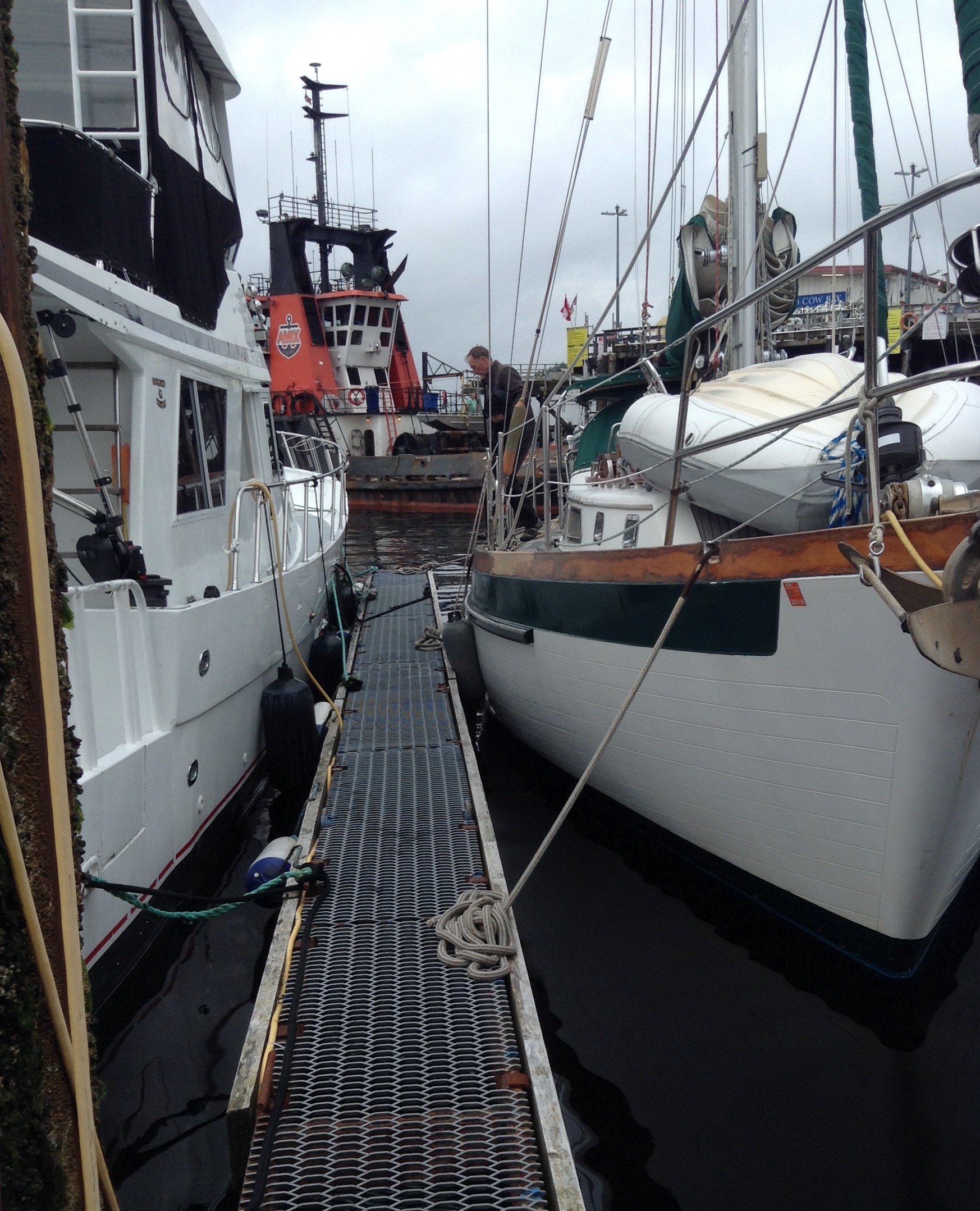
Baraka at the dicey docks of the welcoming Prince Rupert Rowing and Yacht Club.
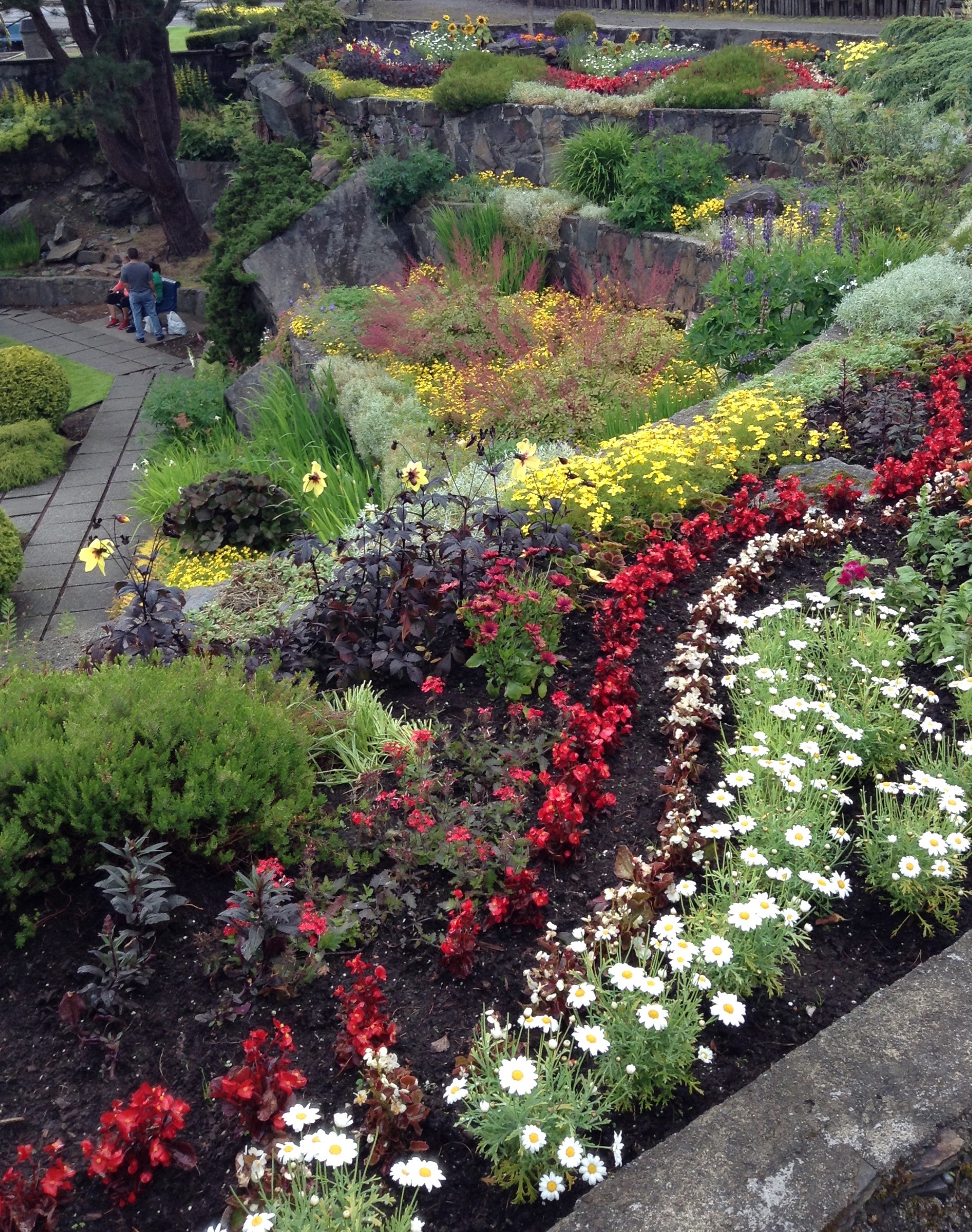
A few steps away we discover a mini Buchart Gardens.
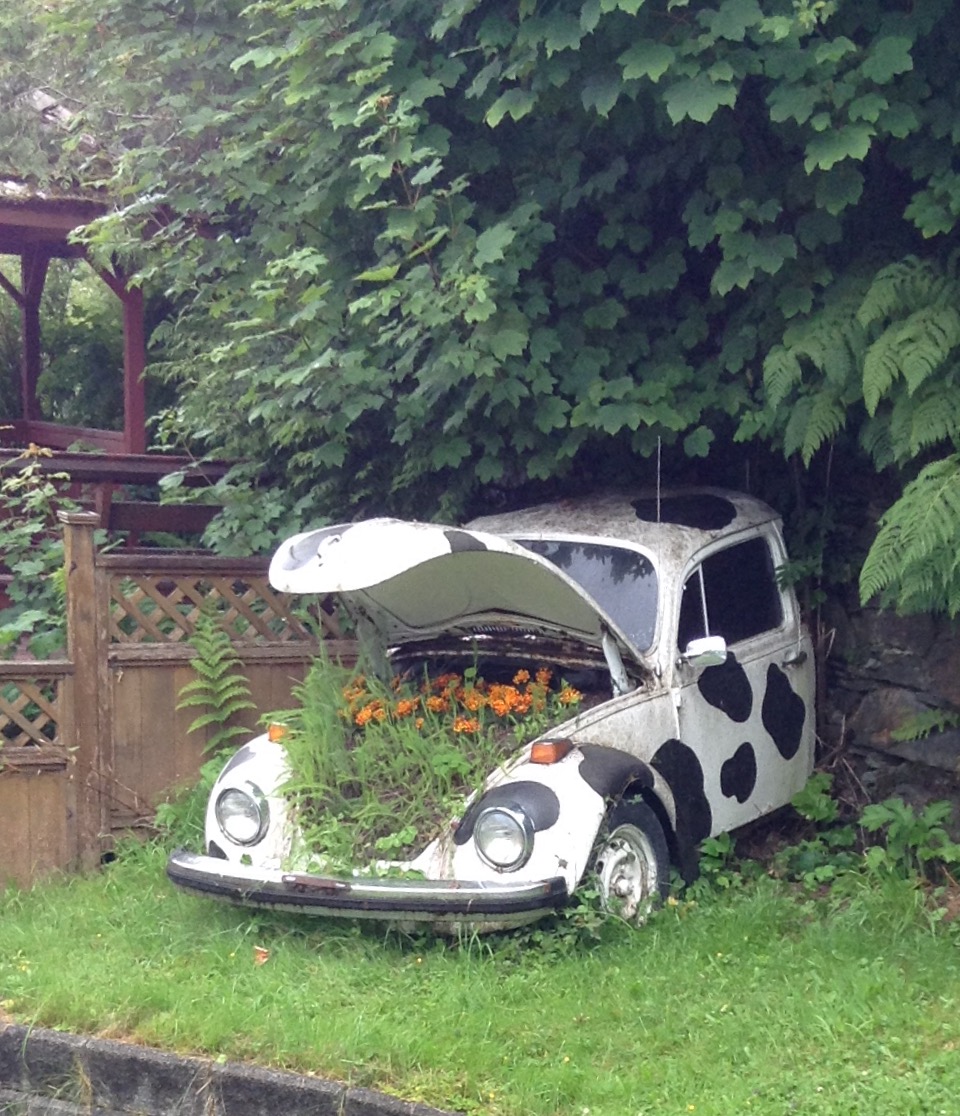
The Prince Rupert Rowing and Yacht Club is located in Cow Bay, a charming gully of shops, beautifully painted wall murals, and everything that can be painted in black and white cow motif, including garbage cans, road dividers, and this yard art.
We have a few boat chores to do - the head is locking up, maybe just worn. We'll pull it and rebuild it again, and see if we can get it working better. PR is our best chance to provision until Port Hardy or McNeill, so we need to take stock.
I am reacting to the black fly bites I got on my face at Dundas. One eye is swollen almost shut, and one cheek has a big inflamed lump. Dave has 0 bites! I am taking anti-histamines. Story of our life: bugs love me and are indifferent to him.
July 16 - Port Edwards
Got the toilet rebuild done and took care of other business, so today was a play day. We took the bus to Port Edwards (Mary's recommendation, thanks!) to visit the largely unrestored cannery, now a heritage site. We arrived just in time for a guided tour of the net sheds, slime line, worker housing, office and company store. The workshop under the net shed was especially interesting. It looks like you could still fire it up and be in operation. Our guide was a first nations Tsimshian woman whose mother had worked in the cannery. She told how the fishermen were towed to the river mouth and left for 6 days in rowboats to fish by net, with a mothership delivering water and food and picking up fish. The cannery ran day and night when the fish were running. Pay depended on your job, fishermen paid by the fish, canners by the tray, but you easily could owe the company store by the end of the season. Housing varied widely, for the Europeans (houses), the Japanese (bunkhouses), and the Natives (small cabins each with 6-12 people).
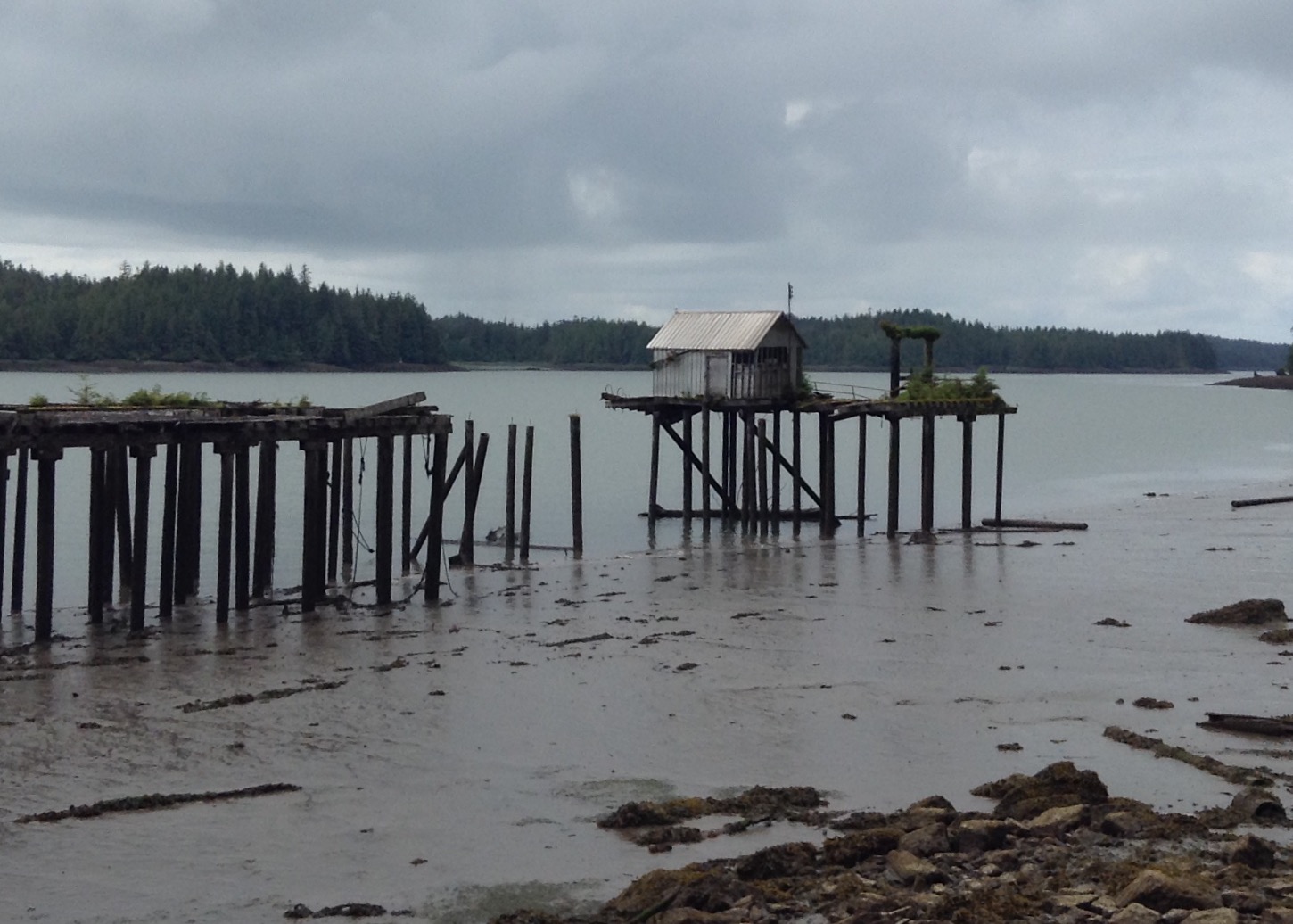
We take the bus to Port Edwards to visit a cannery museum.
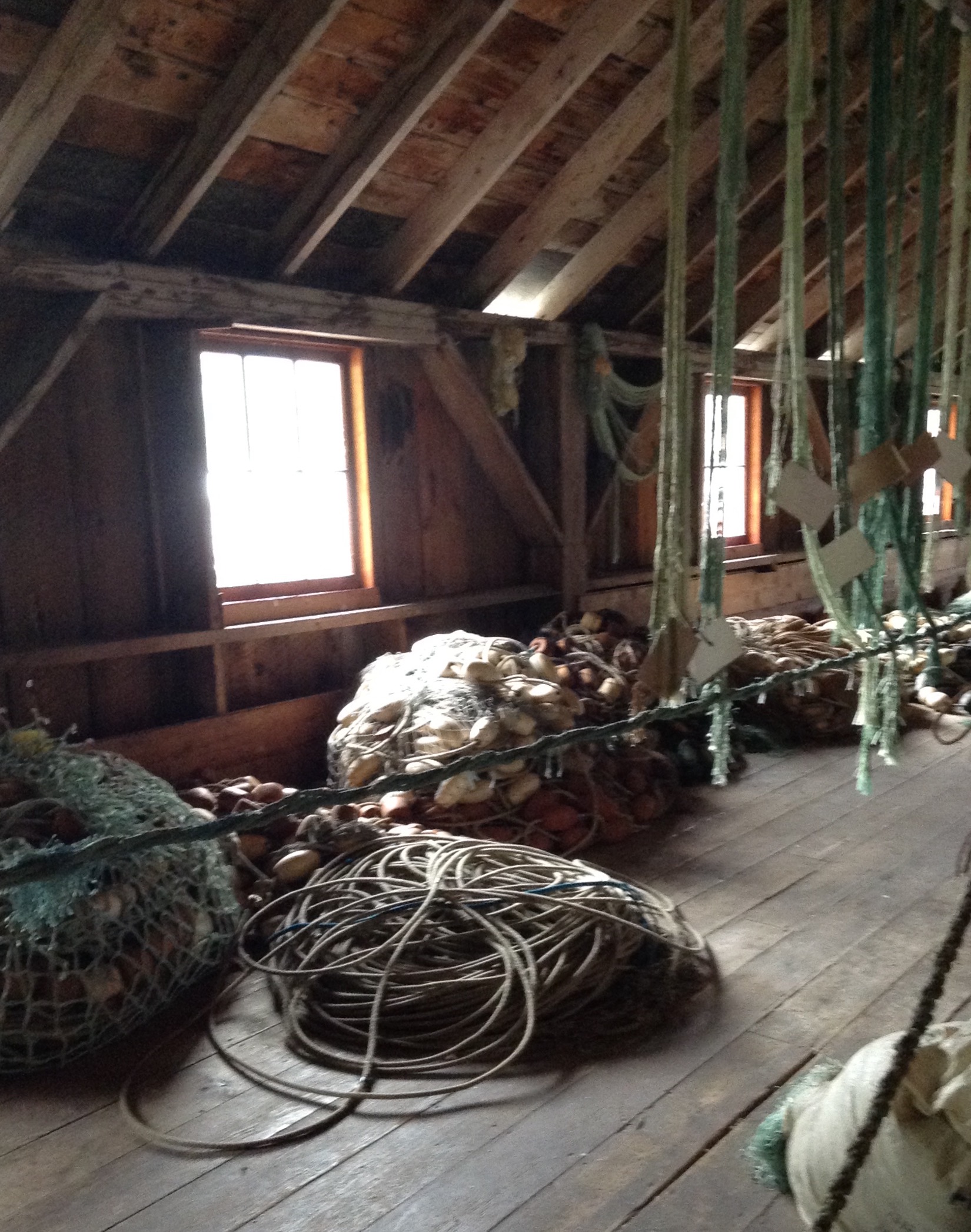
The net shed looks like the workers have just stepped out for a smoke.
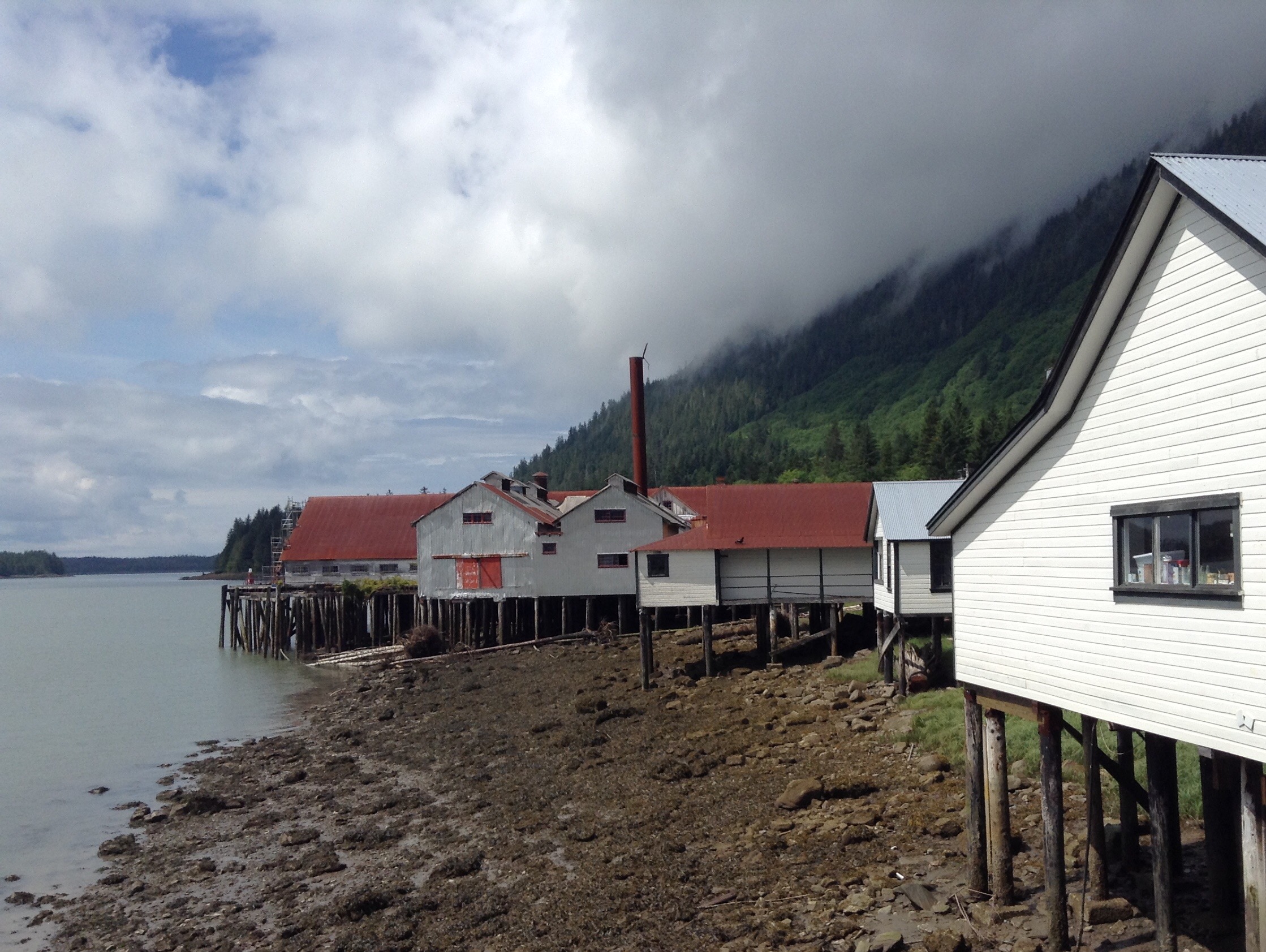
Our guide takes us into a variety of buildings
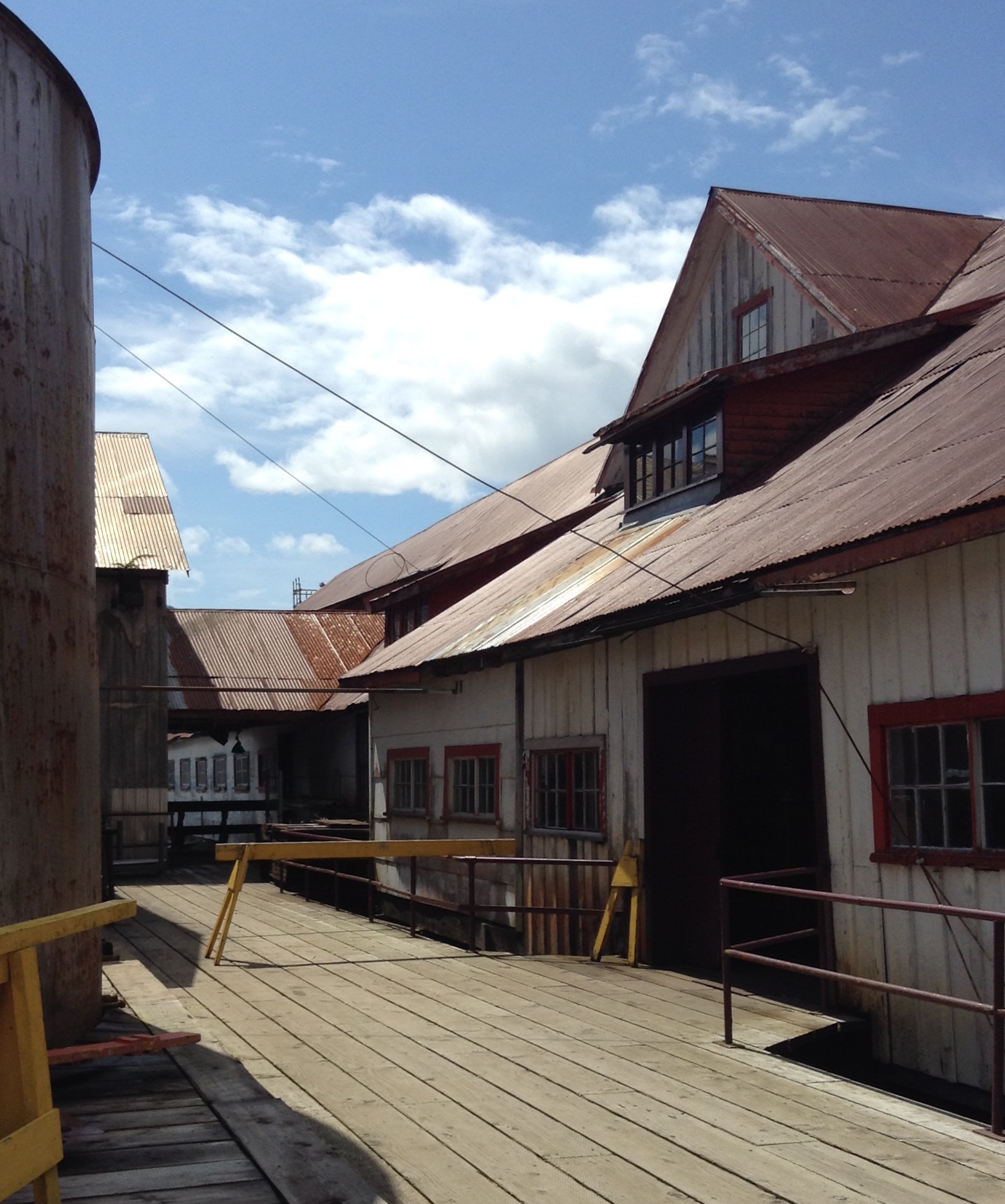
and tells us about cannery life.
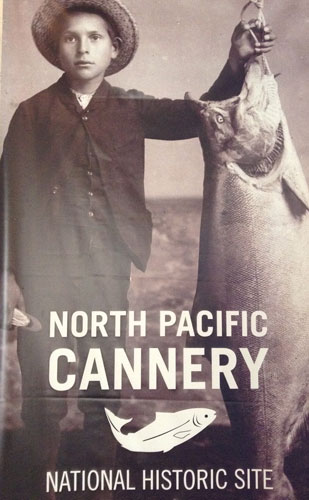
Housing was different for "Europeans" (whites), Japanese and Natives, as were conditions and pay.
Back aboard Dave is rebuilding the mount for the engine seawater intake. It has 2 rusted bolts. Probably would get us home... but once Dave discovers an issue he tries to cure it before it breaks.
Tomorrow we will provision up, and top off tanks, and head out Tuesday.
July 18 - Spicer Islands
Up this morning early to try to slide into the fuel dock, but by the time it opened at 7 am, the dock was already full, plus a Coast Guard cutter was hovering. We waited nearly a hour, bobbing around, while other fishing boats arrived to join the queue. This is the sole fuel dock for all of Prince Rupert, which means there is always a queue. Seems to work, skippers are courteous and keep track of their turn. We tooted in and grabbed a spot just aft of the big cutter, and took on 280 liters. Dave calculates in gallons and must do the conversion, then figure it out in US dollars for his log.
Beautiful day, sunny and almost warm! And it is Dave's birthday, very low-key event, celebrated with a lonely card from the dollar store.
We glided in flat water all the way to the Spicer Islands, our jumping off point for tomorrow's long run to Haida Gwaii.
Dave and I visited Haida Gwaii once before, back when it was called the Queen Charlotte Islands, when we were BB (between boats). We took the car ferry from Rupert and enjoyed several days on the north island, then joined a kayak tour for the south island. The kayak tour was memorable because of the steady monsoon, which kept us inside our small dome tent much of the week, though we did get to paddle to Ninstints, an historic Haida settlement, now a ruin with falling down totems.
July 19 - Queen Charlotte City
Woke to thick fog. The radar showed a halo of it, something we'd never seen before. Motored out to Hecate Strait and were partway across before it lifted. We motor-sailed all day with reefed main and full gib in light winds and calm seas, then turned into Skidegate Channel. Because of the extensive shoal, we were another 3 hours to Queen Charlotte City, where we anchored in Bearskin Bay near the marina. Long day, but conditions probably as good as it gets!
July 20 - QC City and car tour
Went ashore to the info center, and called car rentals. Lucked out, And 5 minutes later Bob showed up with a minivan, about $100 for 24 hours. We ran up the island to Masset for lunch and a visit to the local maritime museum, small but packed with interesting things including a photo of a razor clam harvester (didn't work). We drove through Old Masset, Haida village, to the graveyard, and back to gift/art with some beautiful and pricy Haida work. We carried on to Tow Hill, and walked on the beach a bit. Trucks and ATVs were driving the beach. Apparently you can go many miles. The roads were lined with deer, who didn't bother looking up from grazing as we drove past. We must have seen 100 today, does with fauns, bucks with racks.
Turning back, we took logging roads to try to find a Haida canoe deep in the woods that we had seen 20 years ago. The info center lady said it was hard to find, but we came across the sign, then hiked up a muddy road, then good trail about a half hour and found it! The forest is reclaiming it, but you can still see the prow shape. Mystery why the Haida selected a tree so far inland, and a second mystery why the project was abandoned. We carried on down the winding logging road, careful not to turn down secondary roads. The ipad nav program didn't show the logging roads but confirmed we were headed the right direction. We eventually popped out in QC City, and dinghied home to Baraka at anchor.
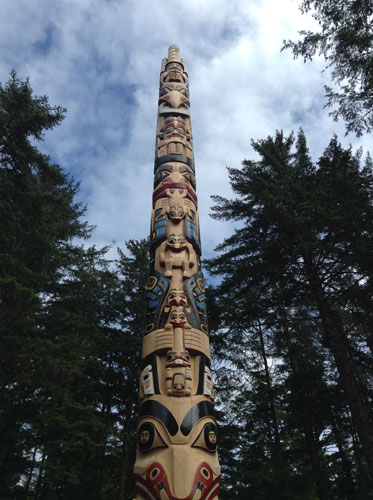
At Tow Hill there is a magnificent new pole
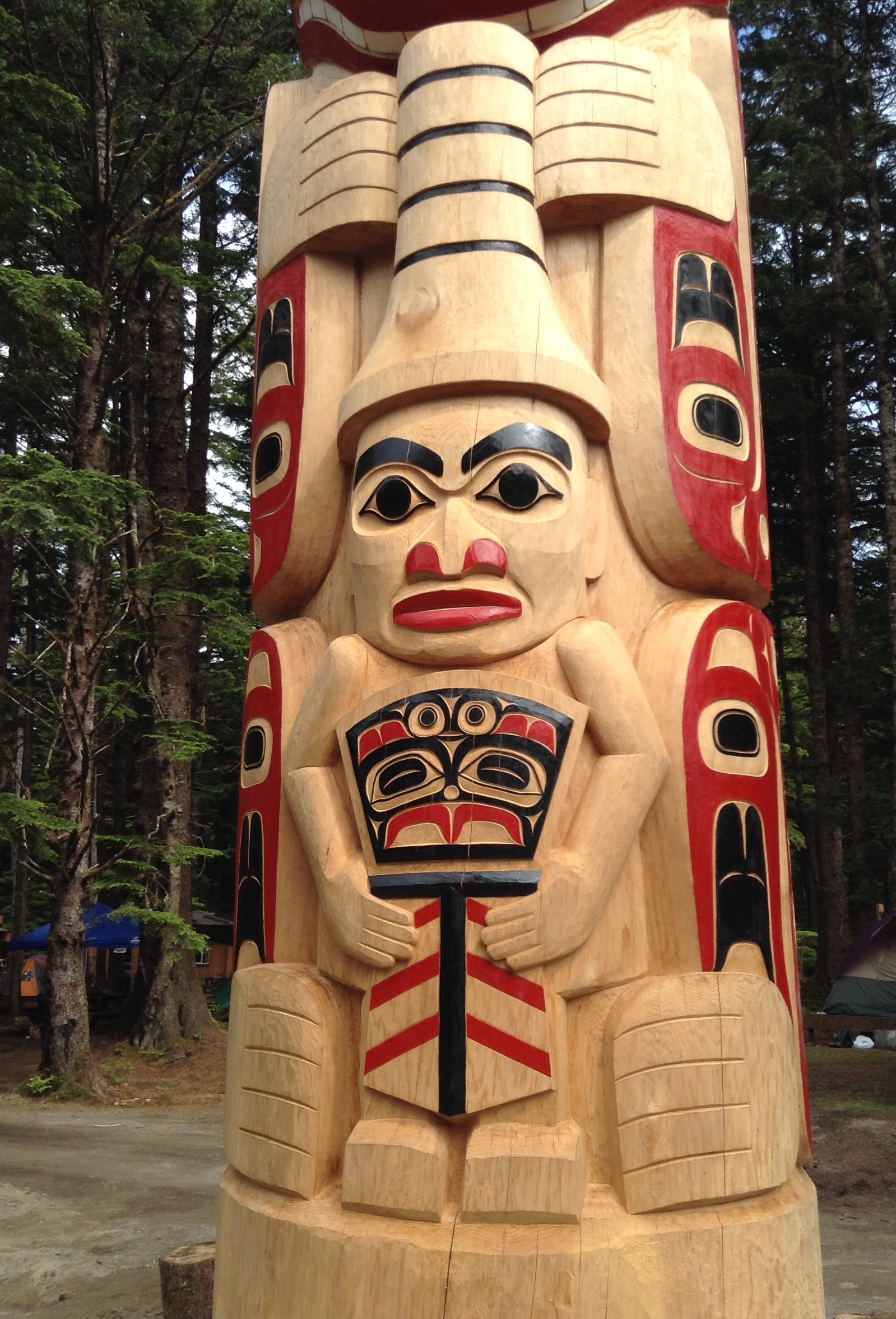
just raised last month. This chief holds a copper signifying wealth.
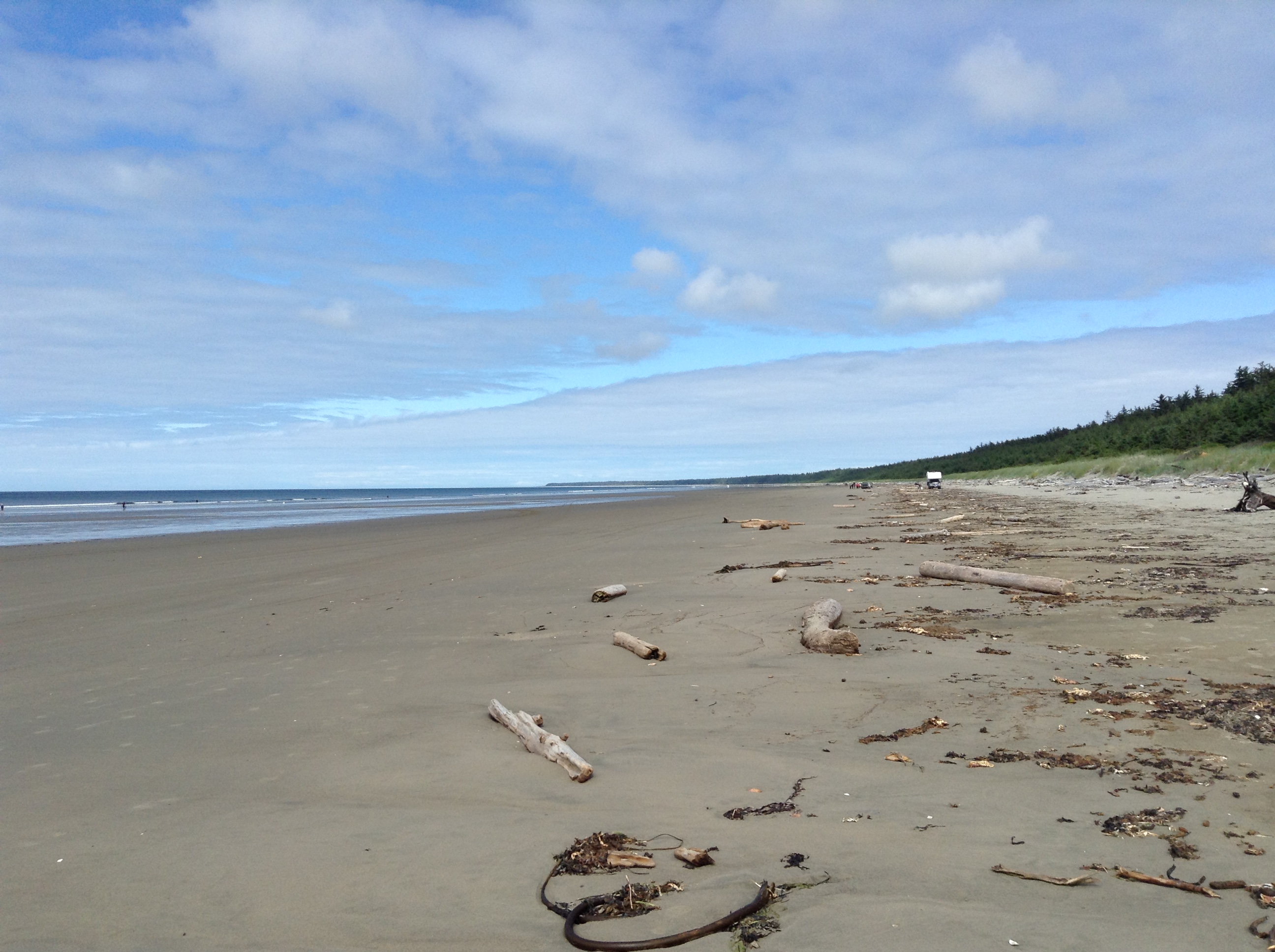
The beach stretches miles to Rose Point.
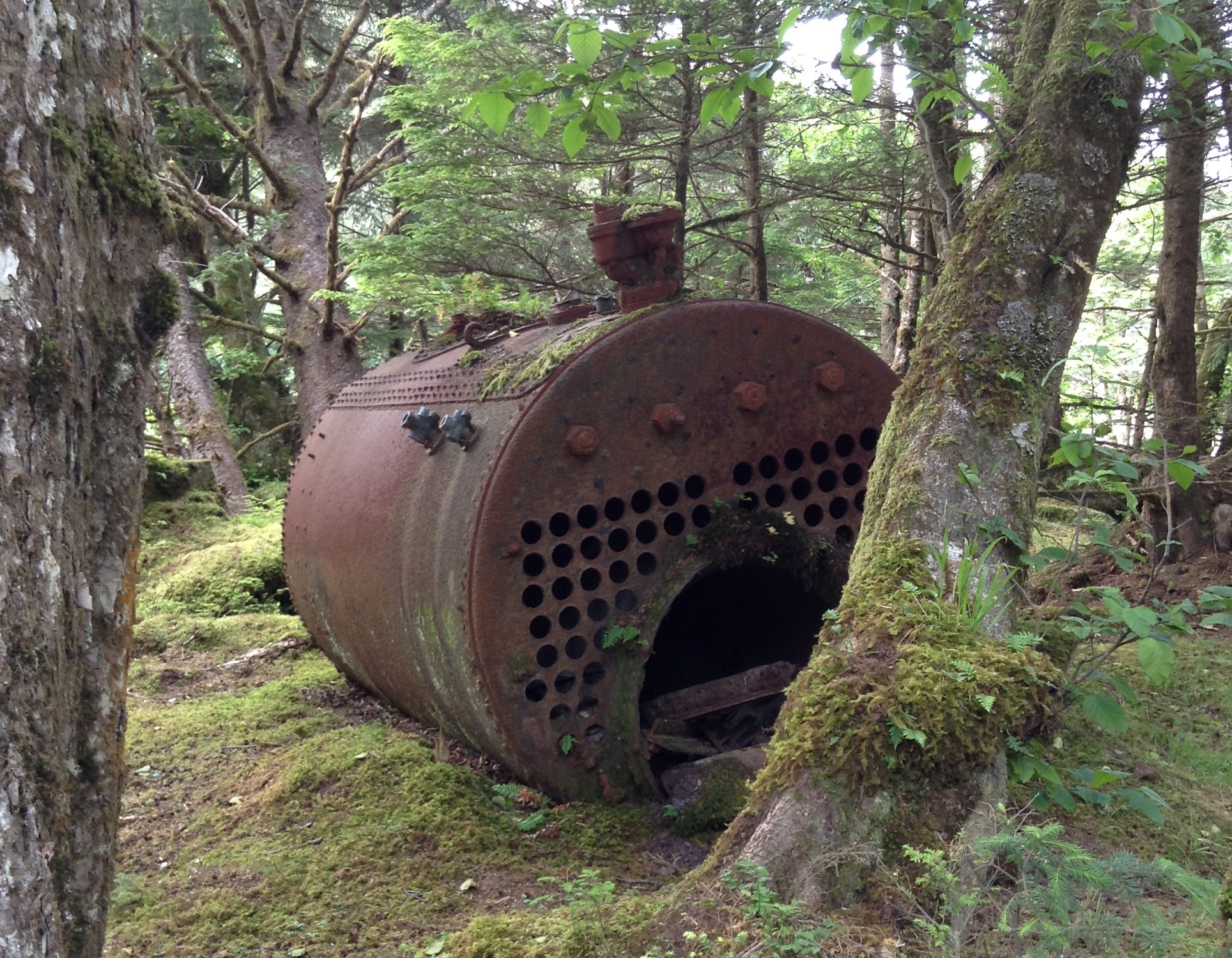
This boiler hints at past industry at Tow Hill.
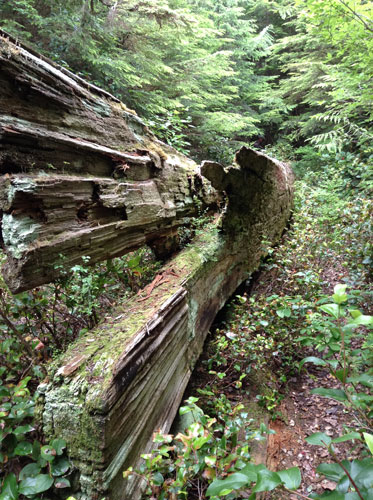
We once again locate the patially carved huge Haida canoe.
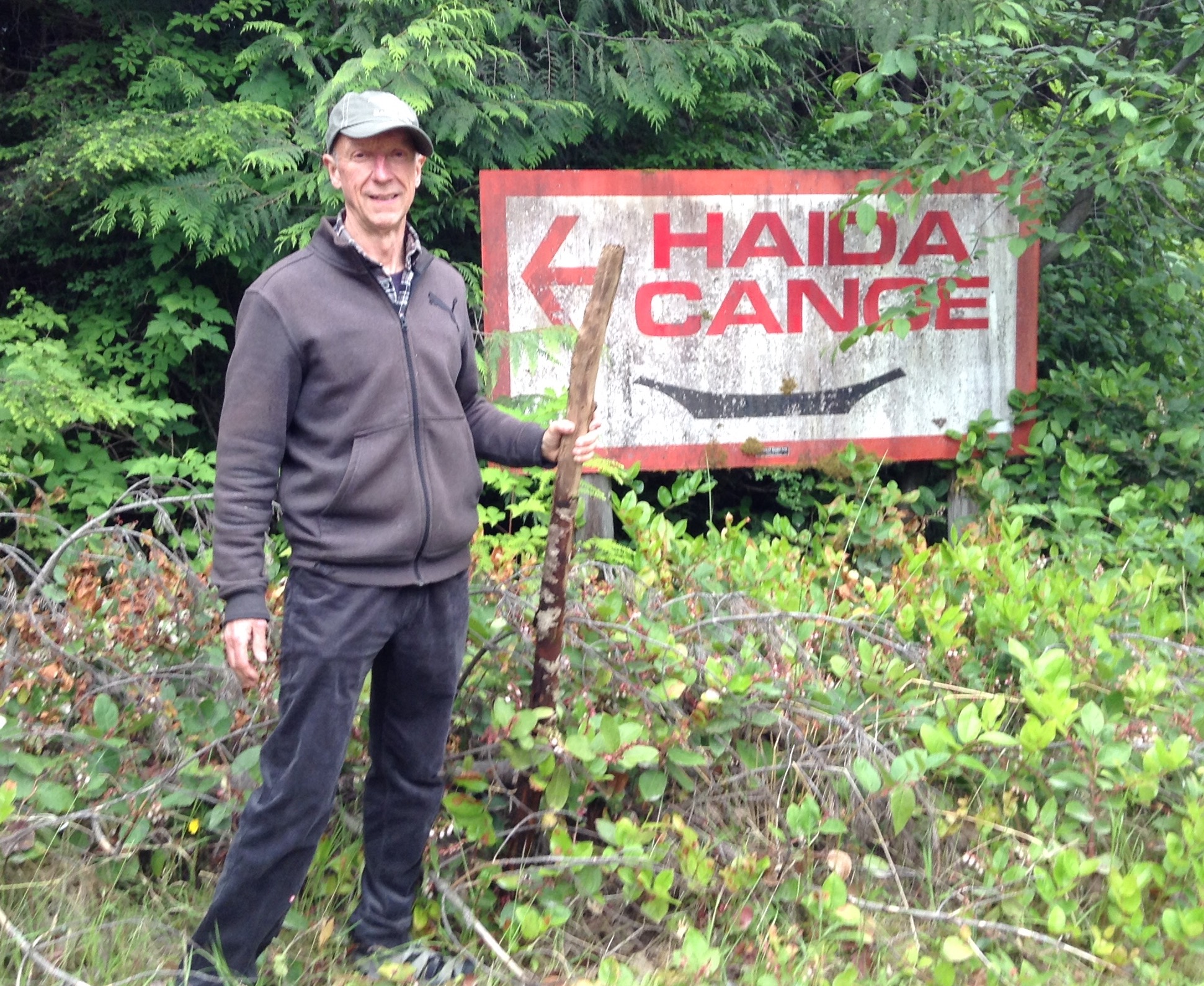
Dave is happy to find it after 20 years.
July 21 - QC City
Rowdy night, with strong winds sending chop into our Bearskin Bay anchorage. Dave threw a second safety line on the trailing dinghy. The generator runs but is not pushing water for cooling, so today's project is an impeller replacement, not quite so trivial since the Westerbeke replacement impellers have a slightly different shaft size, requiring modification.
We were up early today, dropped the outboard on the dinghy and headed in to the marina, a sloppy ride in cold chop. We hopped into the rental car to run over to Skidegate Landing for the Gwaii Haanas required orientation session. A park ranger who is a local Haida woman gave an informative lecture on the history and ecology of the park, plus all the dangers: weather, tides, uncharted rocks, currents, bears, rats, how to avoid whales, plus restrictions on bird and sealion nesting colonies. Dave wondered if some visitors drop out after the orientation. There are an awful lot of rules, but Gwaii Haanas is also a rarity - a glimpse into a vanished civilization. We will hopefully visit several villages, once thriving towns, that were pretty much decimated by the smallpox introduced by early traders. Haida Gwaii tells the story of the. virtual extermination of old growth forests, otters, whales, and Haida. These are very slowly coming back, but will never equal their former abundance.
Yesterday when we saw all those cute deer, we didn't appreciate that they were introduced here in the 1890s as a protein source. They have all but wiped out the forest floor brush, impacting native flora and fauna. The overharvest of sea otters meant the proliferation of urchins, which in turn wiped out the kelp forests. The orientation told how the Lyall island timber boycott let to the creation of Gwaii Haanas as a protected reserve. We returned the rental car by leaving it unlocked at the marina, key above the visor! On the sloppy ride home we retrieved the crab traps (one female, one too small). Our crab count stands at zero for the year. Now Dave has the genset apart and is replacing the culprit impeller.
Weather looks rough another day, then clocks NW, still strong but we should be in the lee and can move along.
July 23 - Skedans
Up today for an early start, weather looking good. Crabpot finally yielded a keeper, yay!
Then arrggghhh. We were foiled by a problem with the windlass. The up switch stopped working when I still had 50 feet of chain out. A few minutes later the down switch wouldn't work either! We let a bit of scope back out and Dave went to work, checking power to the breaker, then to the switches. This narrowed the culpit(s) to the foot switches. He took the up switch off the deck and cleaned and rotated the contact. Voila! We decided we could move along without the down switch working, though I do use it at the start of anchoring, to position the anchor before the drop. But I can do that without the switch. Odd that both chose to fail today. Dave called it a sympathetic failure. I think he made that term up.
This has been an odd summer. One by one each of the boat systems seem to cry for attention. Dave must be getting tired of the daily challenge, but I have yet to hear him complain. By then it was noon. Our first anchorage is 40 miles away with no possible shorter stop. We decided to go anyway. Leaving QC to head south, you must first work an hour north, up a long channel. We looked at the tide to decide where we could safely cross the sandspit bar. When we did, least water I saw was 29 feet.
We headed south along Morseby, well offshore in surprisingly shallow water, 36 feet. Hecate Strait is all shallow. Haida Gwaii was once connected to the mainland until glacier melt raised the waters.
We made good time, arriving at Skedans by 6:30 and anchoring in the open bay just south. It looks like a sandy bottom, reading the shoreline and contour map, but the kelp patches tell us there is also some rock here. Our anchorage is open to the strait, so we have a gentle massaging roll.
Warm evening and no bugs, so crab dinner in the cockpit. We have the bay to ourselves except for a kayakers tent on the shore, visible only with binoculors.
July 24 - Skedans and Tanu to Echo Bay
Calm night. After breakfast we hailed the Skedans watchman (woman) on channel 6 for permission, then took the dinghy around the corner to land on the gravelly beach. We stretched the dinghy anchor line up the beach and buried the anchor in rocks.
At the watchman house we met a young Haida woman, Kelsey, who gave us a memorable tour, of standing and fallen poles and sunken house foundations, telling us a lot about Haida history and culture. I wish we had a recording of it all! She talked about village life, the importance of potlatches, how a man's sister's son inherited his chief title and was responsible for his memorial, that the rings on memorial poles represent how many potlatches a person gave, the range of trading, and some family details. The generation who are elders now were sent away from their family to residence school, in an attempt to eradicate Haida culture through assimilation. Because of this some of those elders are reluctant to talk of the old ways. A recent effort in Skidegate resulted in the first Haida dictionary in 2016. She showed us pictures and drawings, and pointed out the faint remnants of carved images, stickleback fish, eagle, bear, and killer whale. When these last poles fall, moss and moisture will quickly erode them. The village had several dozen houses, each holding up to 30 people of an extended family. It was abandoned in 1879 after the second smallpox epidemic, when missionaries persuaded the handful of survivors to relocate to Skidegate.
Back at the dinghy, the incoming tide line was above our anchor. We easily waded out to it, then returned to Baraka. On the way we extricated our crabtraps from a snarl of bull kelp. One buoy had disappeared under a kelp raft. No crab here.
We pulled anchor and ran south 10 miles to Tanu. Again we radioed the watchman, and were told Walter would meet us on the beach. Soon an older man appeared, guiding a group that was now leaving. Walter walked us through the village of 30 ruins, pointed out corner poles, entrance poles, mortuary poles and roof beams. The environment is quickly consuming the remnants of the village. In another dozen years there may be little trace. Walter told us about 20 years ago a team from UBC came and took most of the remaining carved poles, placing them in a museum down south. Walter felt this was a mixed blessing, good because future generations can have a glimpse of this vanished life, and sad that the poles were removed from their rightful place. Again he told the story of how contact all but wiped out his race, going from 20000 to 500 in a few short years due to smallpox. Both Skedans and Tanu gave us a glimpse into Haida history and culture. At the watchman's house we met Water's wife Mary and daughter Raven, and learned a bit more about the watchman program.
As much as we've travelled, we find this experience unique, tragic in some respects, and heartwarming to see the proud Haida rebuilding their heritage in new ways.
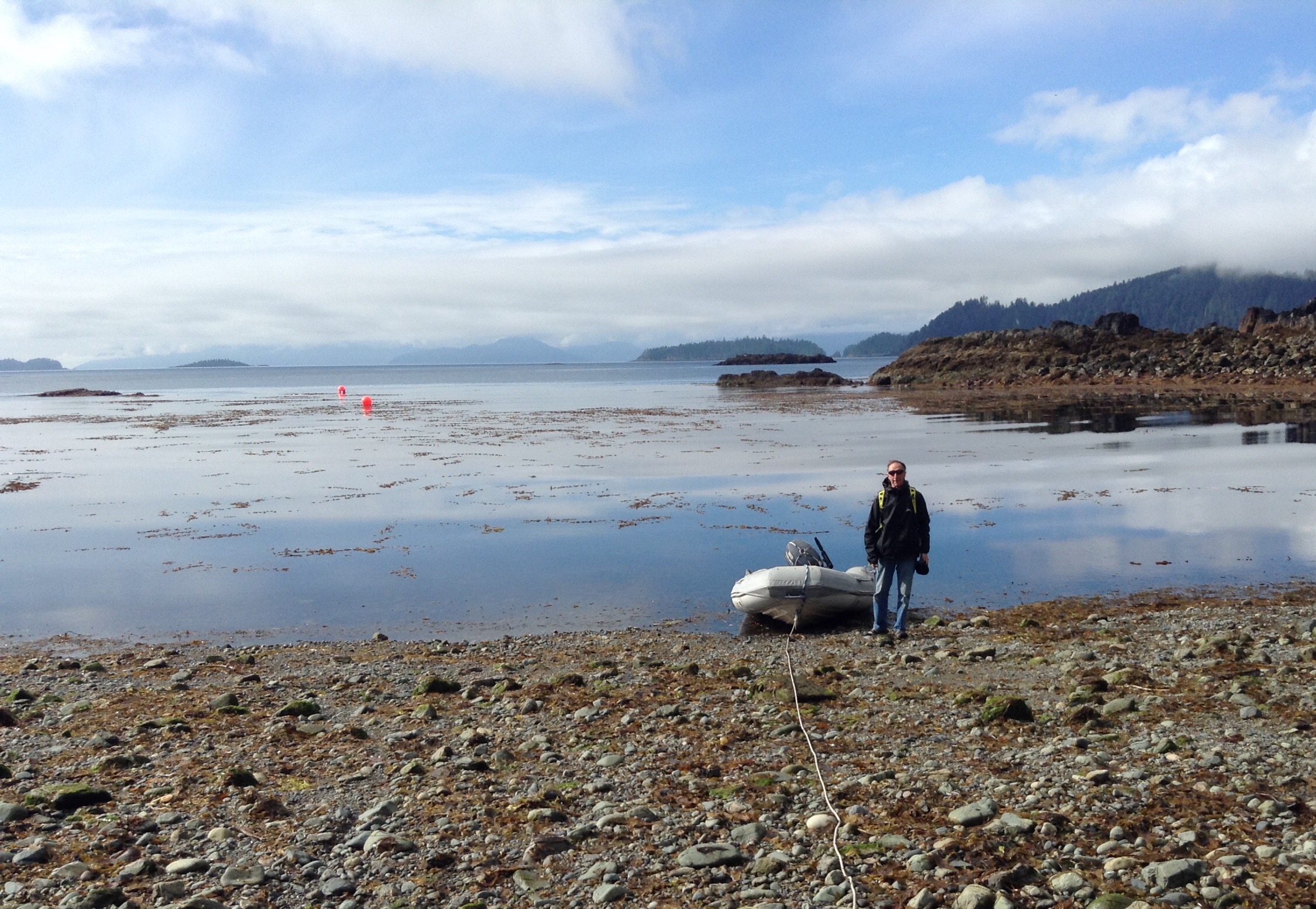
We dinghy ashore at Skedans
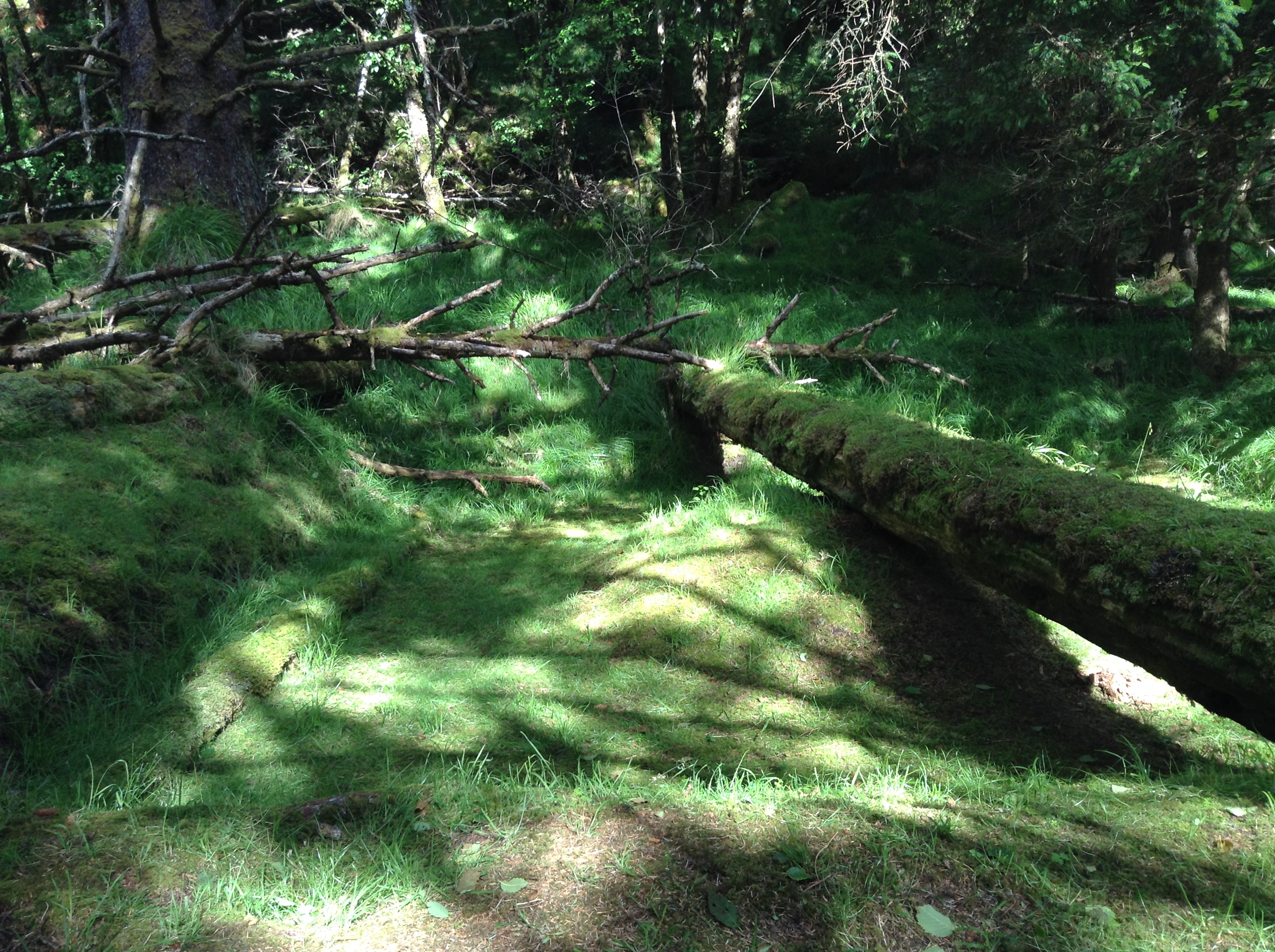
to find the mossy ruins of a Haida village.
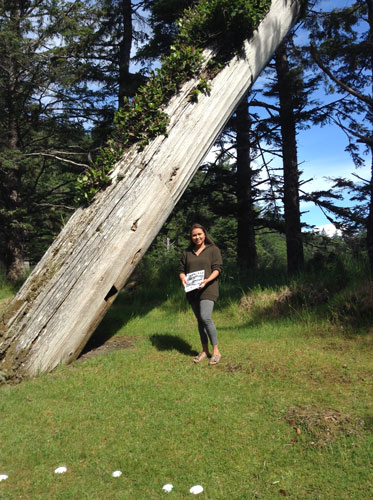
Our guide, Watchman Kelsey, points out details
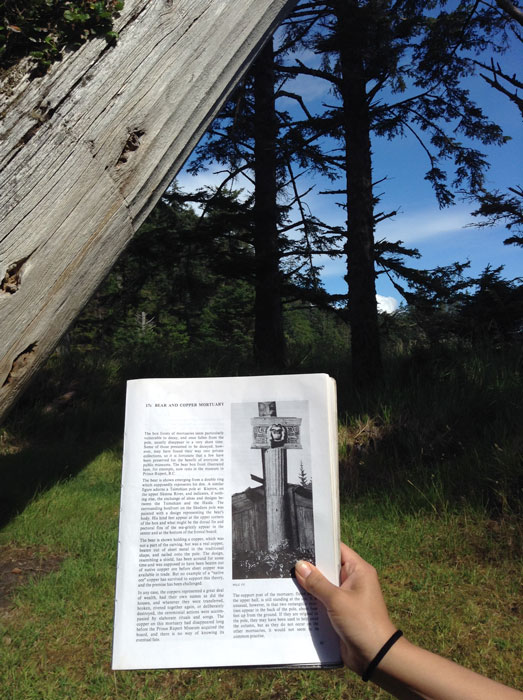
like a fluted column, carved in imitation of stone columns in Victoria.
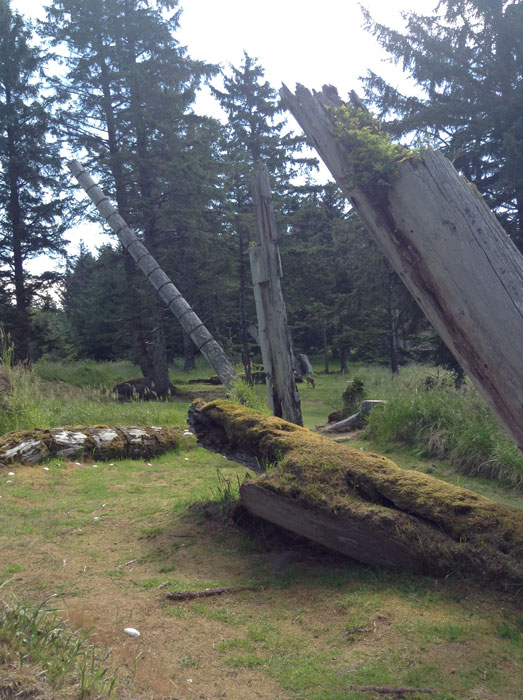
Some posts and poles are still standing, though leaning.
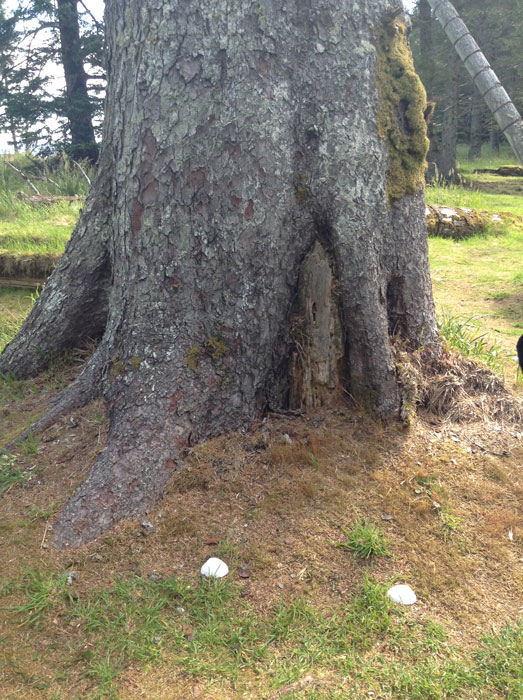
Others have become nurse logs to much larger live trees.
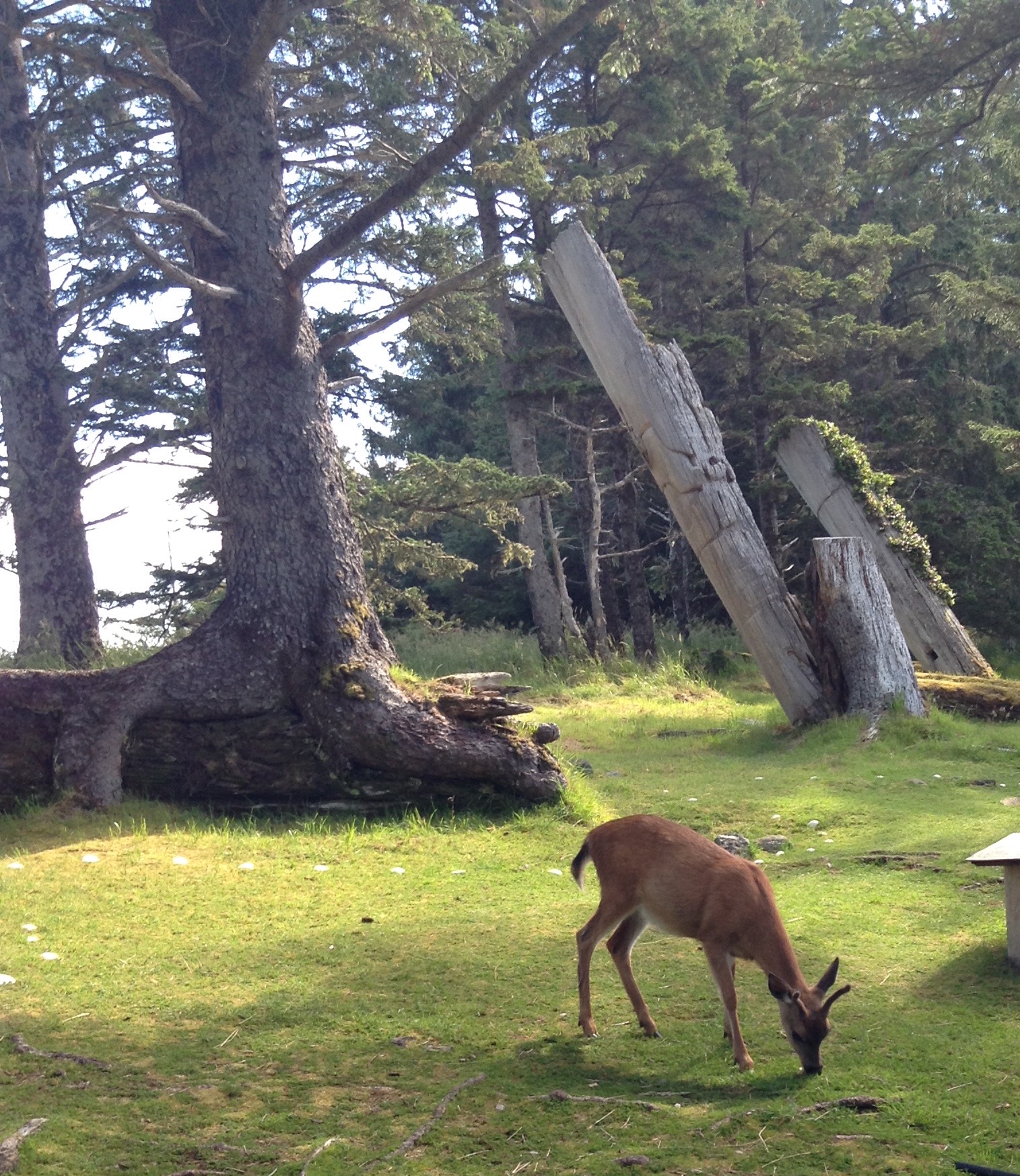
Imported Sitka deer are pretty but voracious shrub eaters.
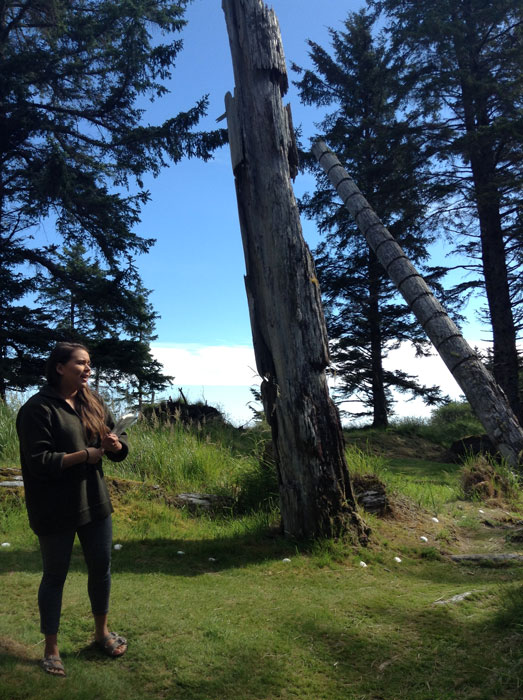
Kelsey explains how smallpox epidemics decimated the Haida, causing the village to be abandoned.
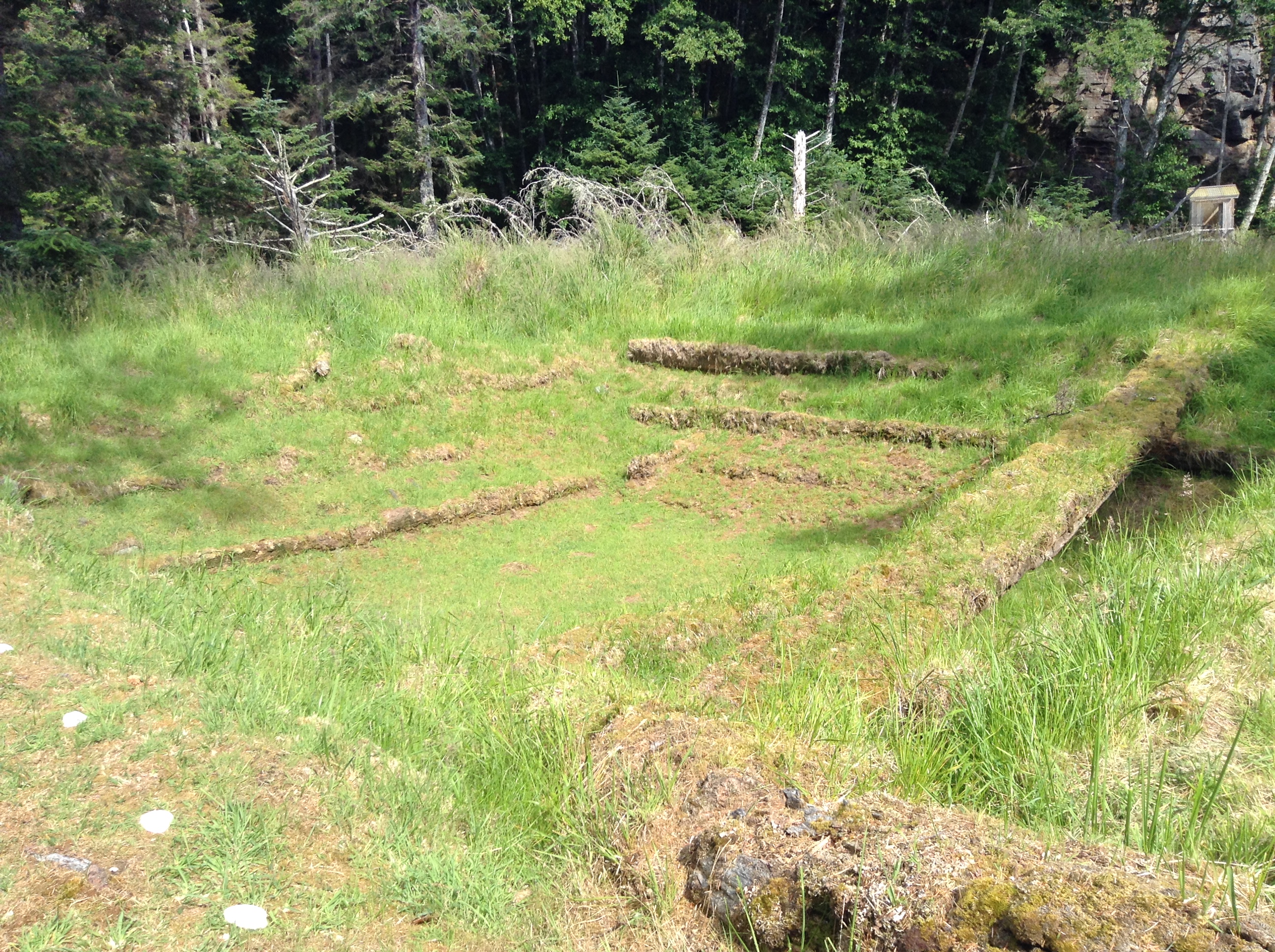
All that remains of a large longhouse are roof beams and the underground pit
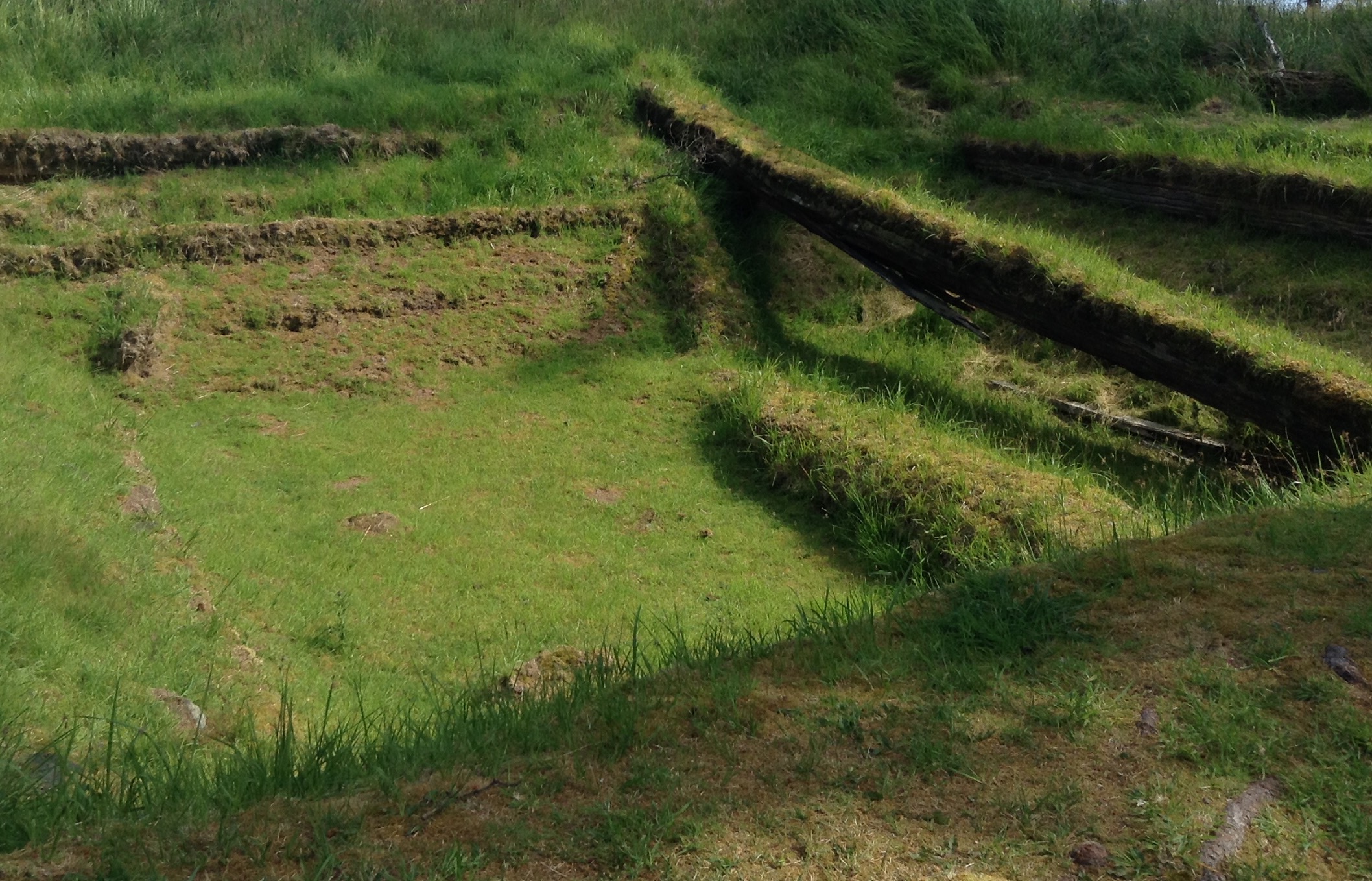
layered with planks for winter warmth below ground.
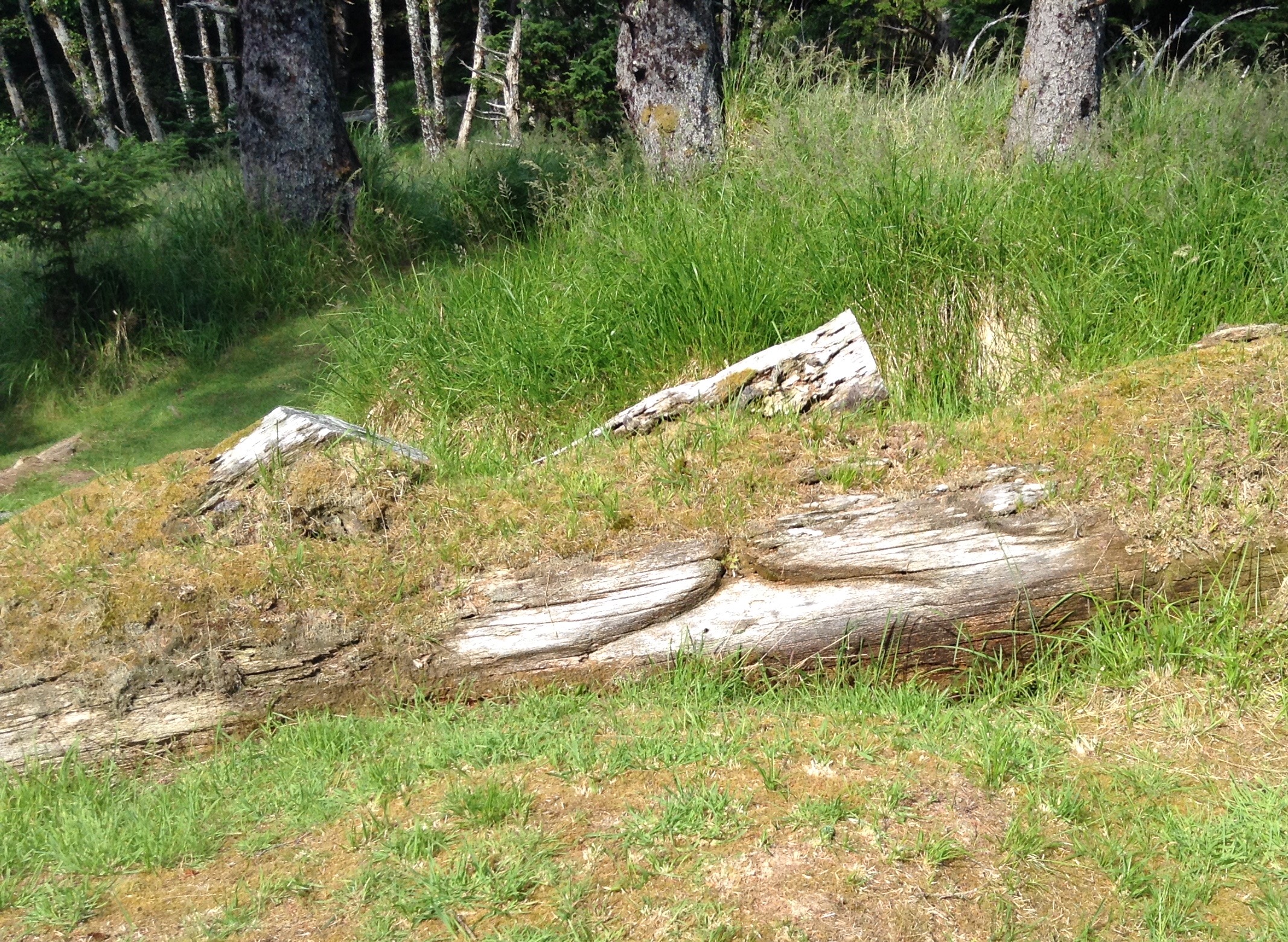
Hints of carving remain
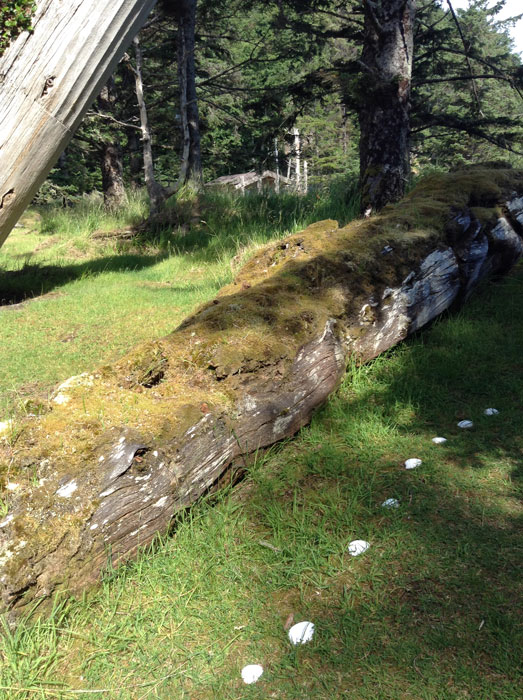
but most is being dissolved under moss.
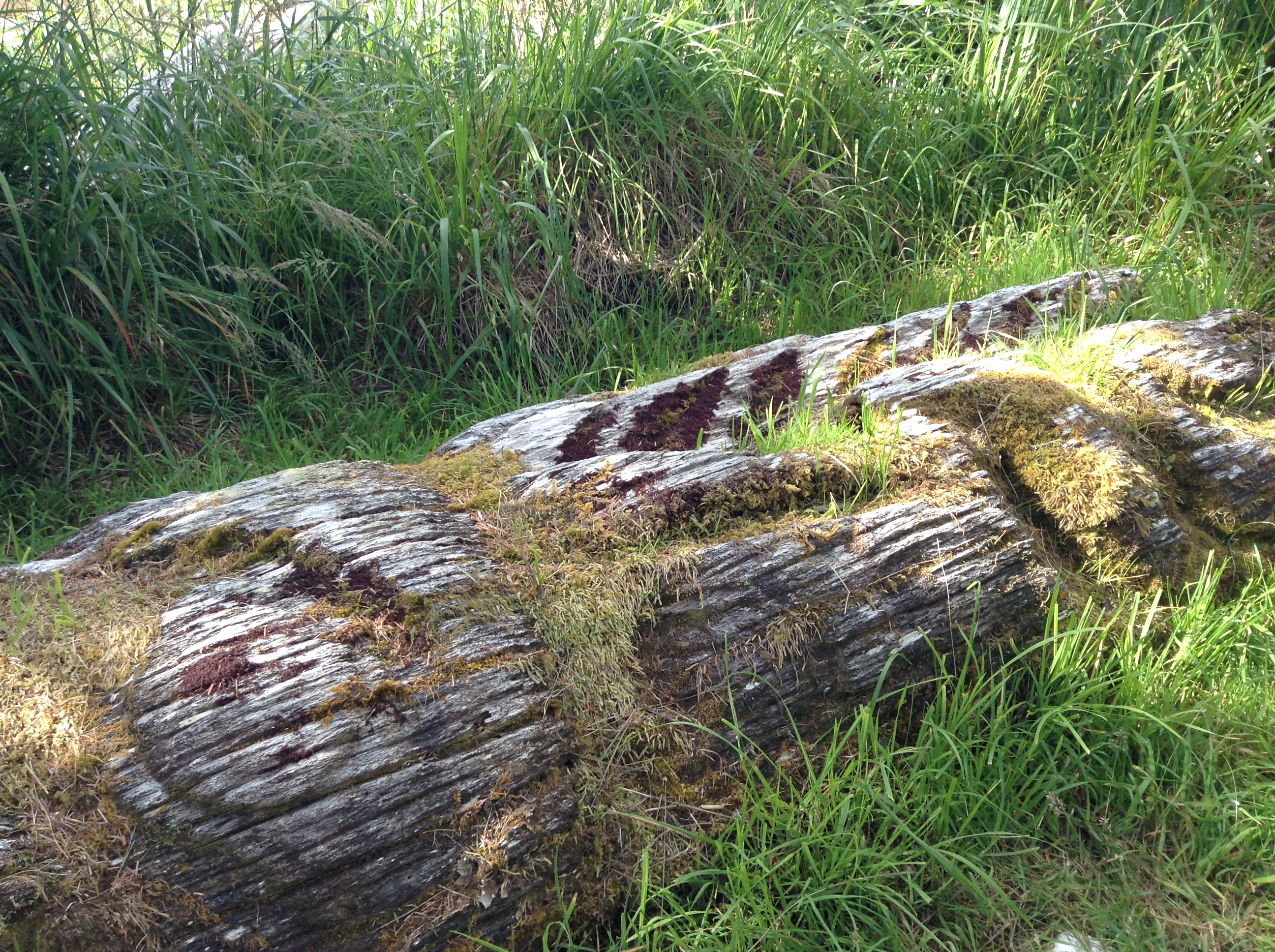
The chevons are part of a carved stickleback fish.
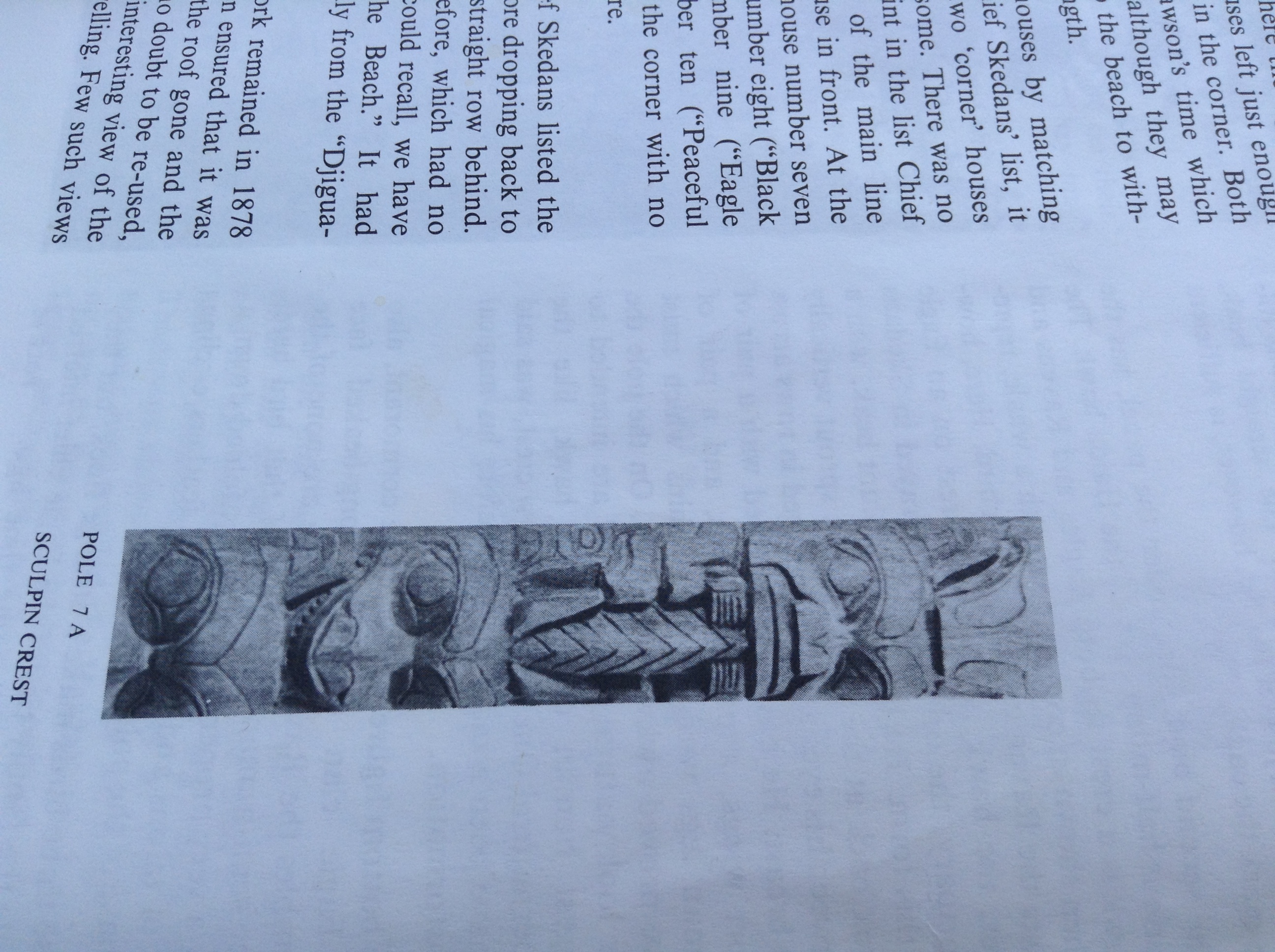
Drawings exist that show the carving details, now lost to nature.
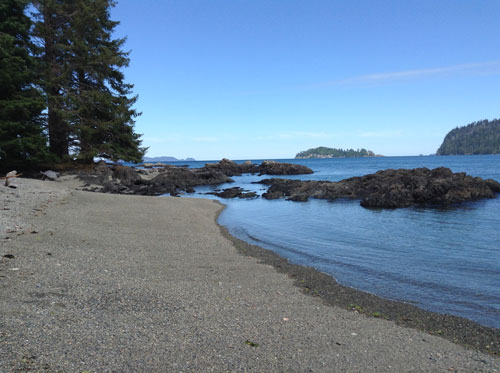
We carry on to Tanu, another watchman site.
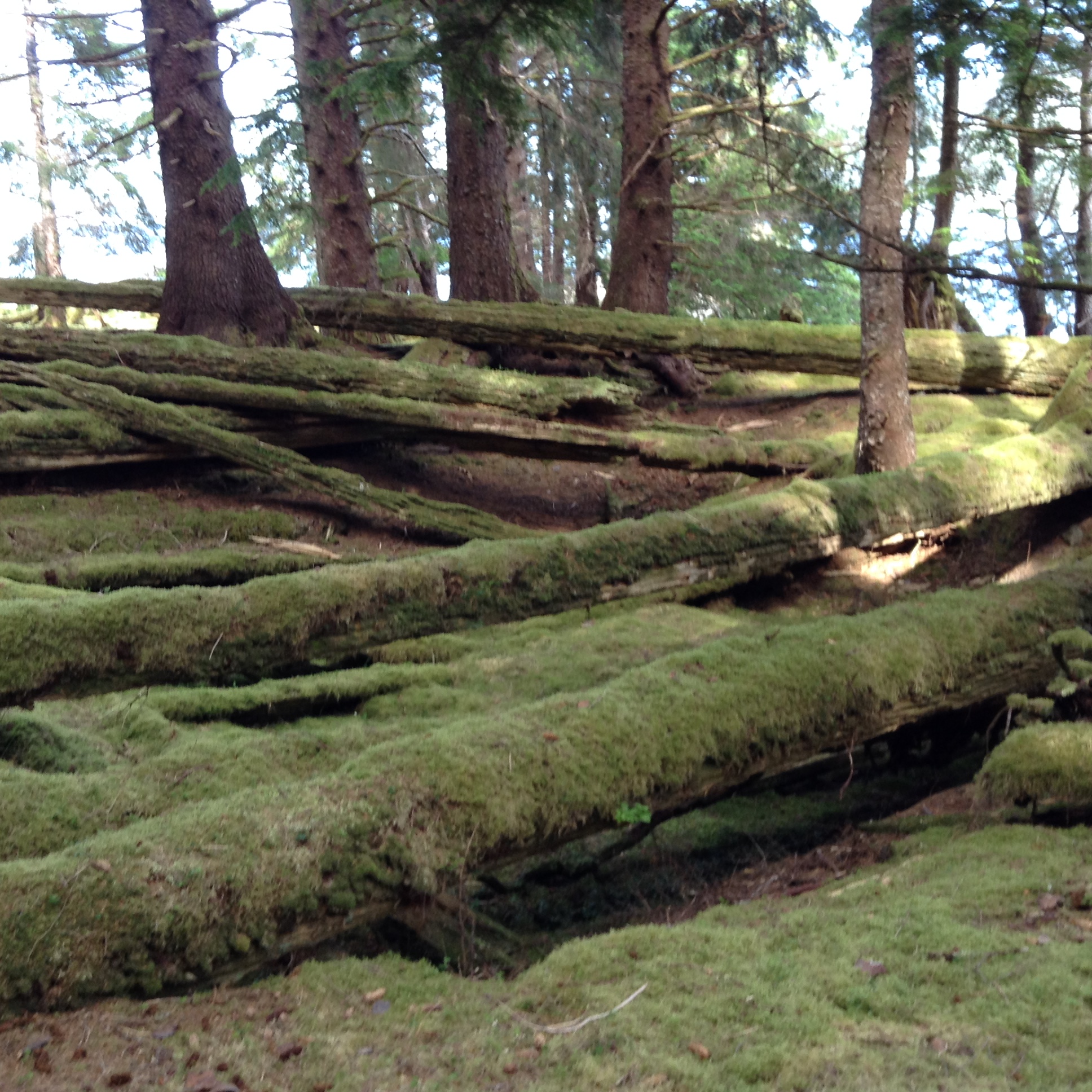
A large village is now in ruins, again abandoned after smallpox.
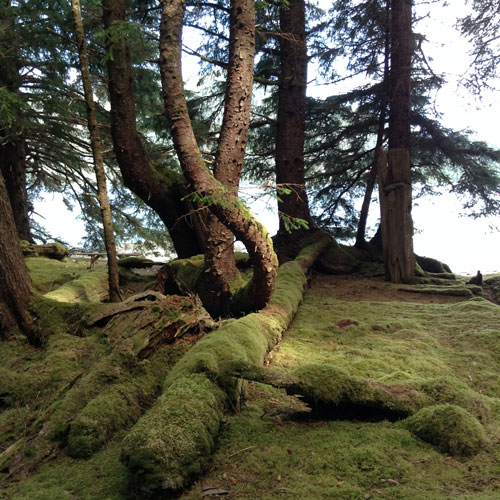
We must stay to the shell paths
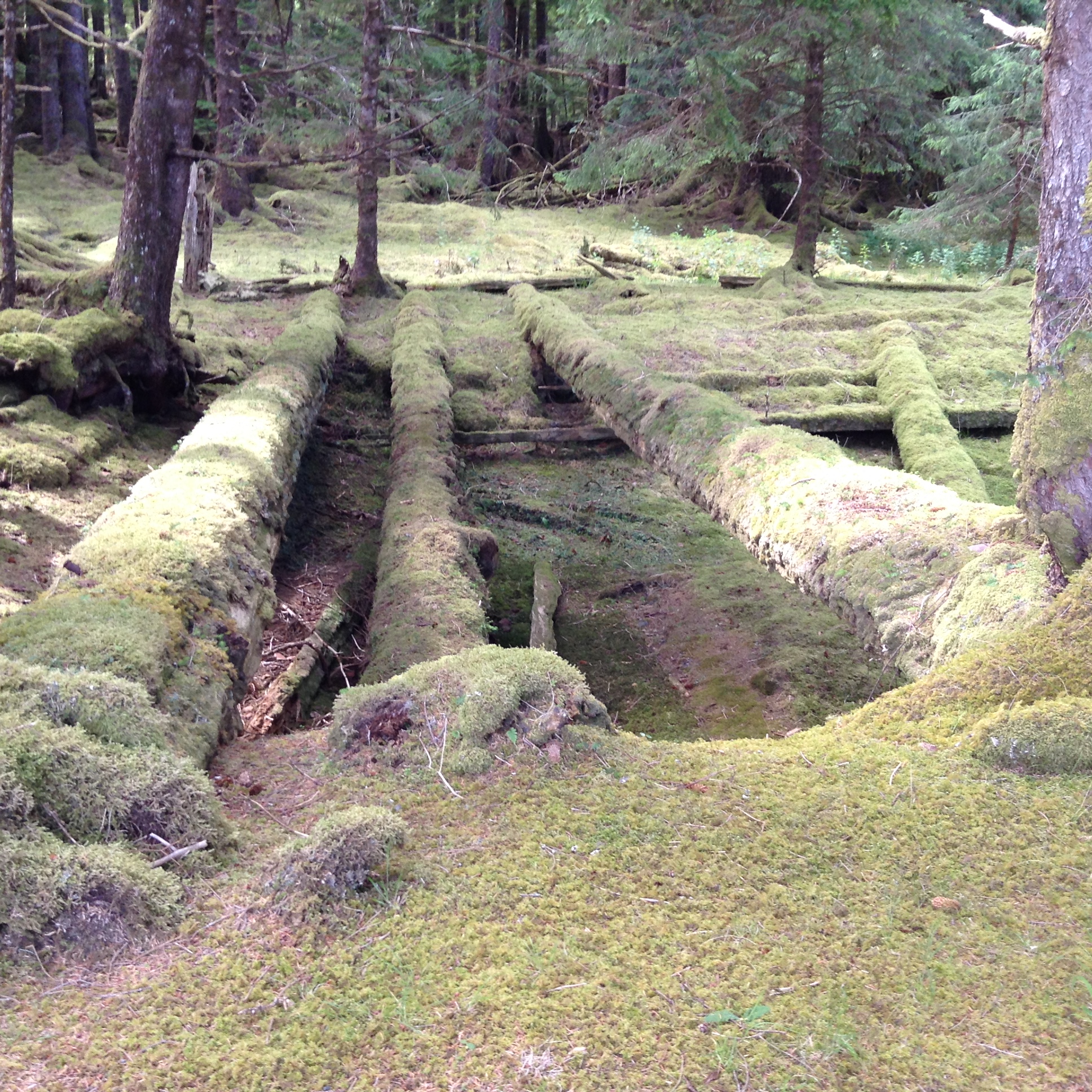
because some bodies were left on the ground.
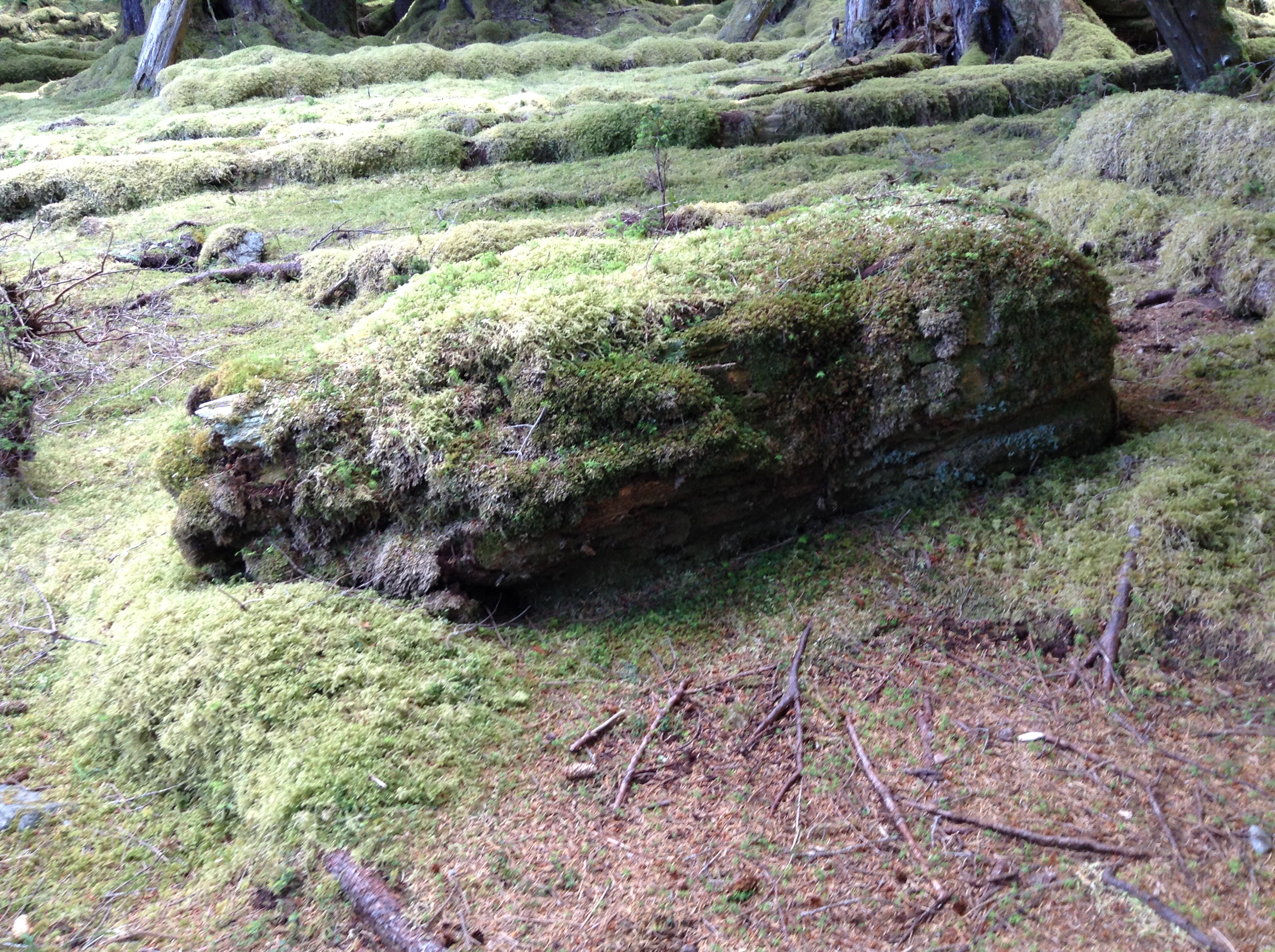
This was a mortuary pole, that cradled a bentwood box coffin. Drawings show the sea wolf carving detail, now lost to moss and decay.
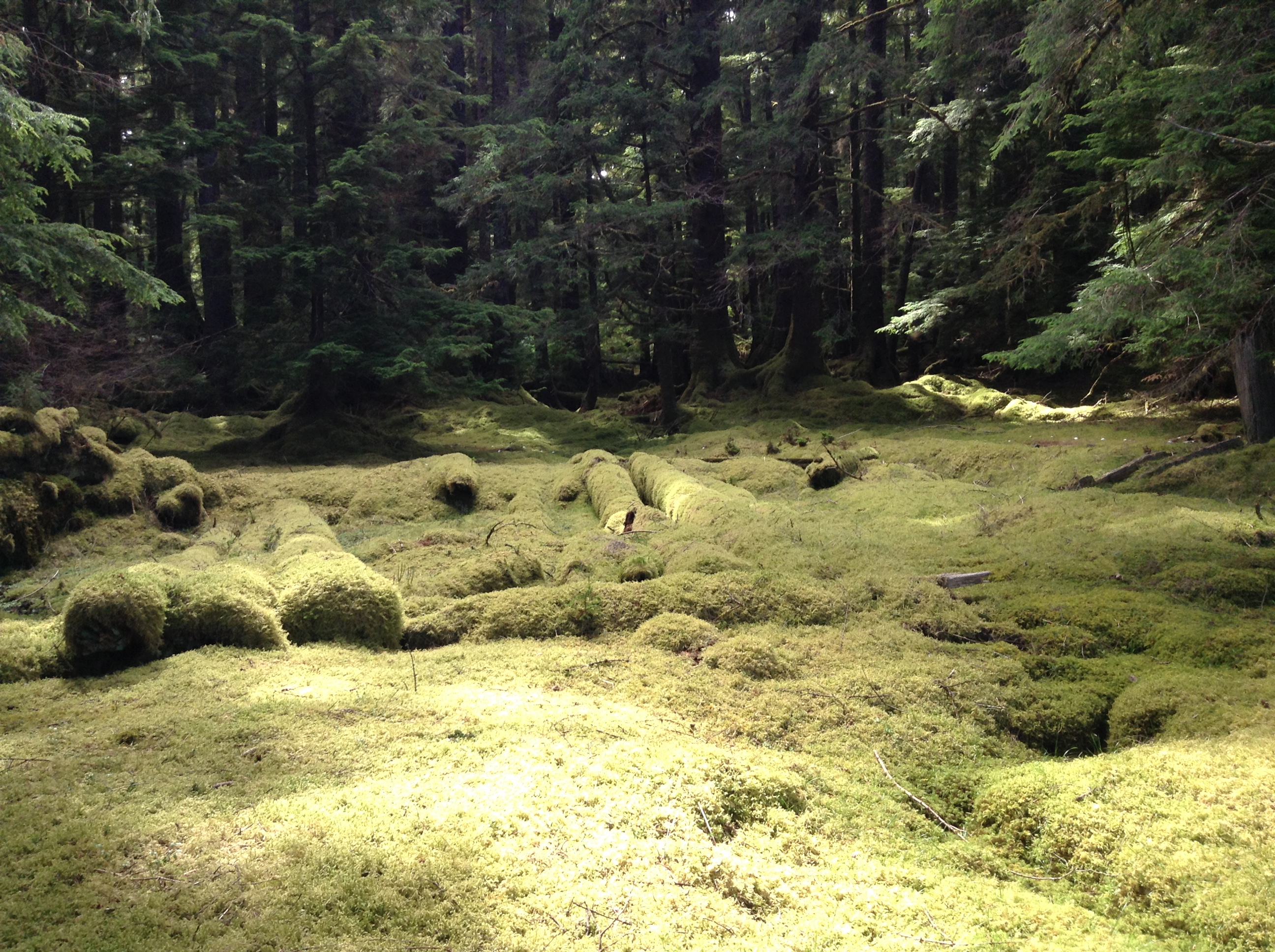
A thick blanket of moss covers all that remains.
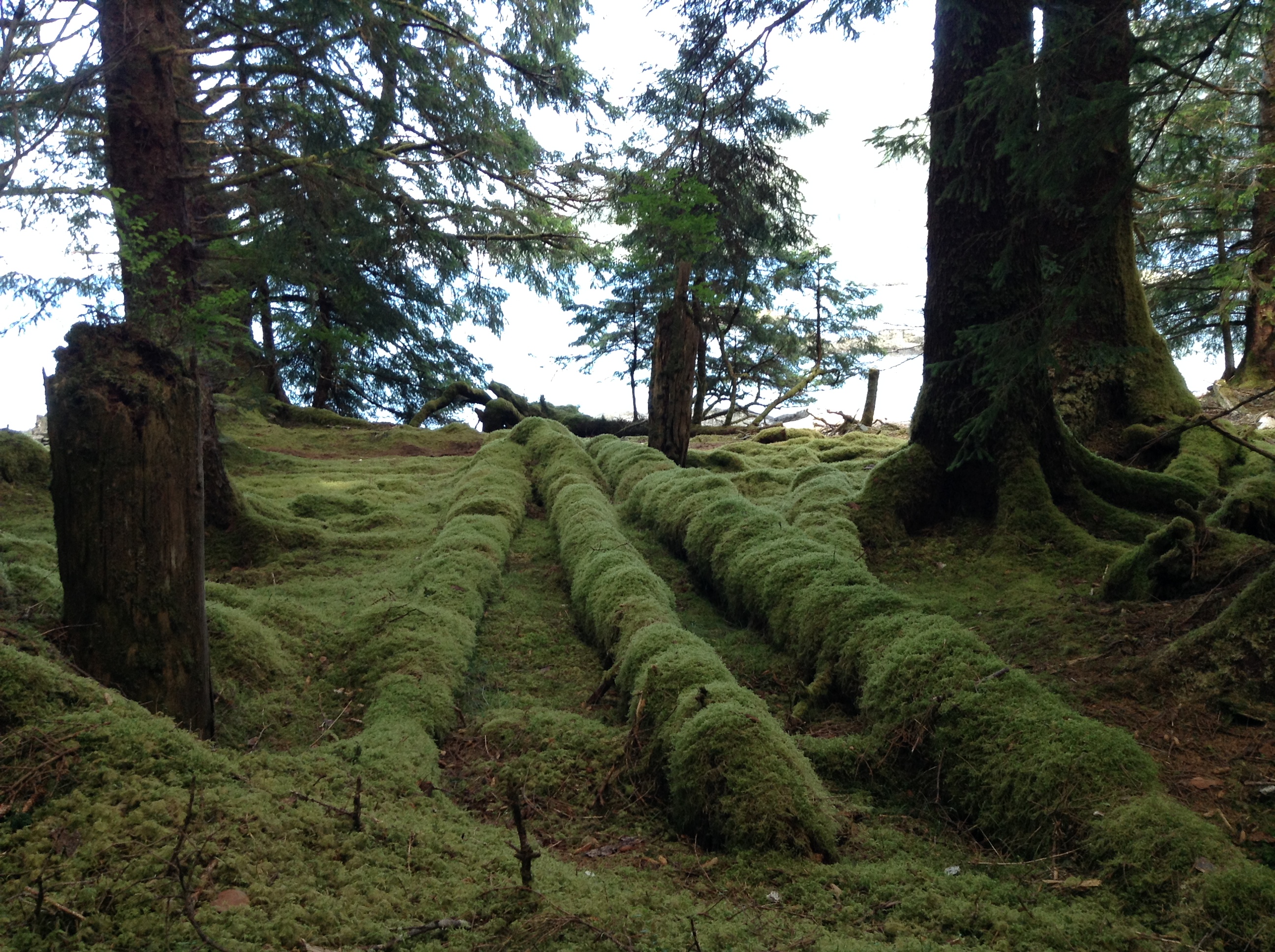
Under the guise of preservation, all carved poles were removed long ago to UBC.
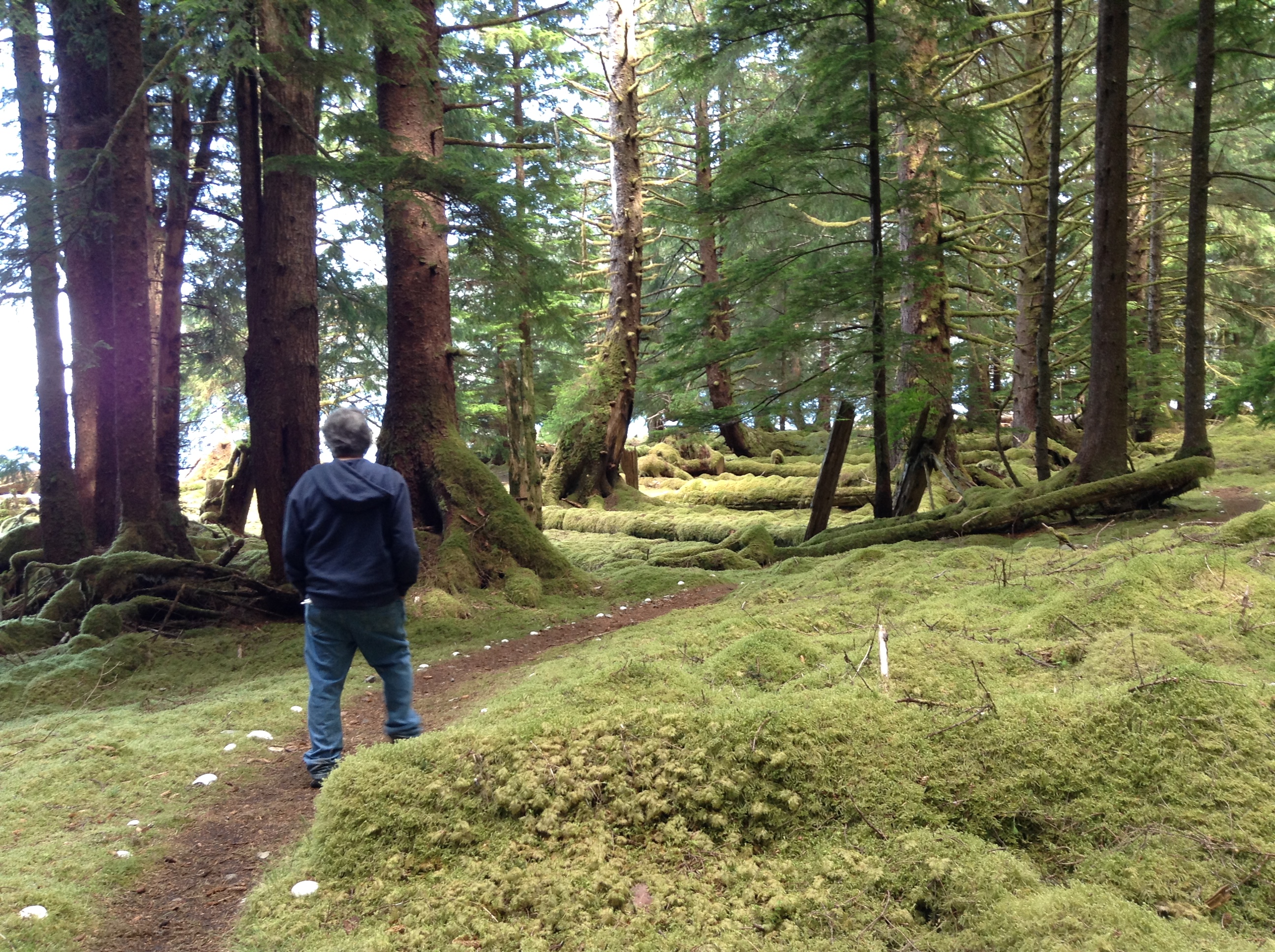
Watchman Walter says this is a mixed blessing, sad because the carvings are not in their rightful place, good because future generations can see their heritage.
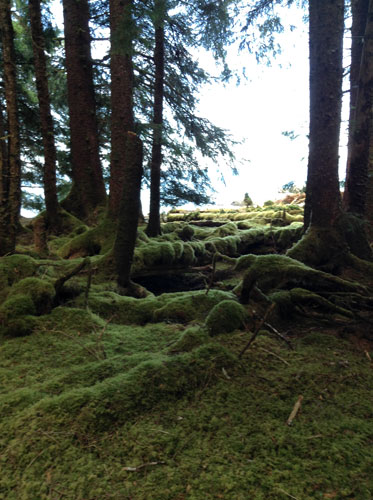
Ruins of dozens of longhouses remain.
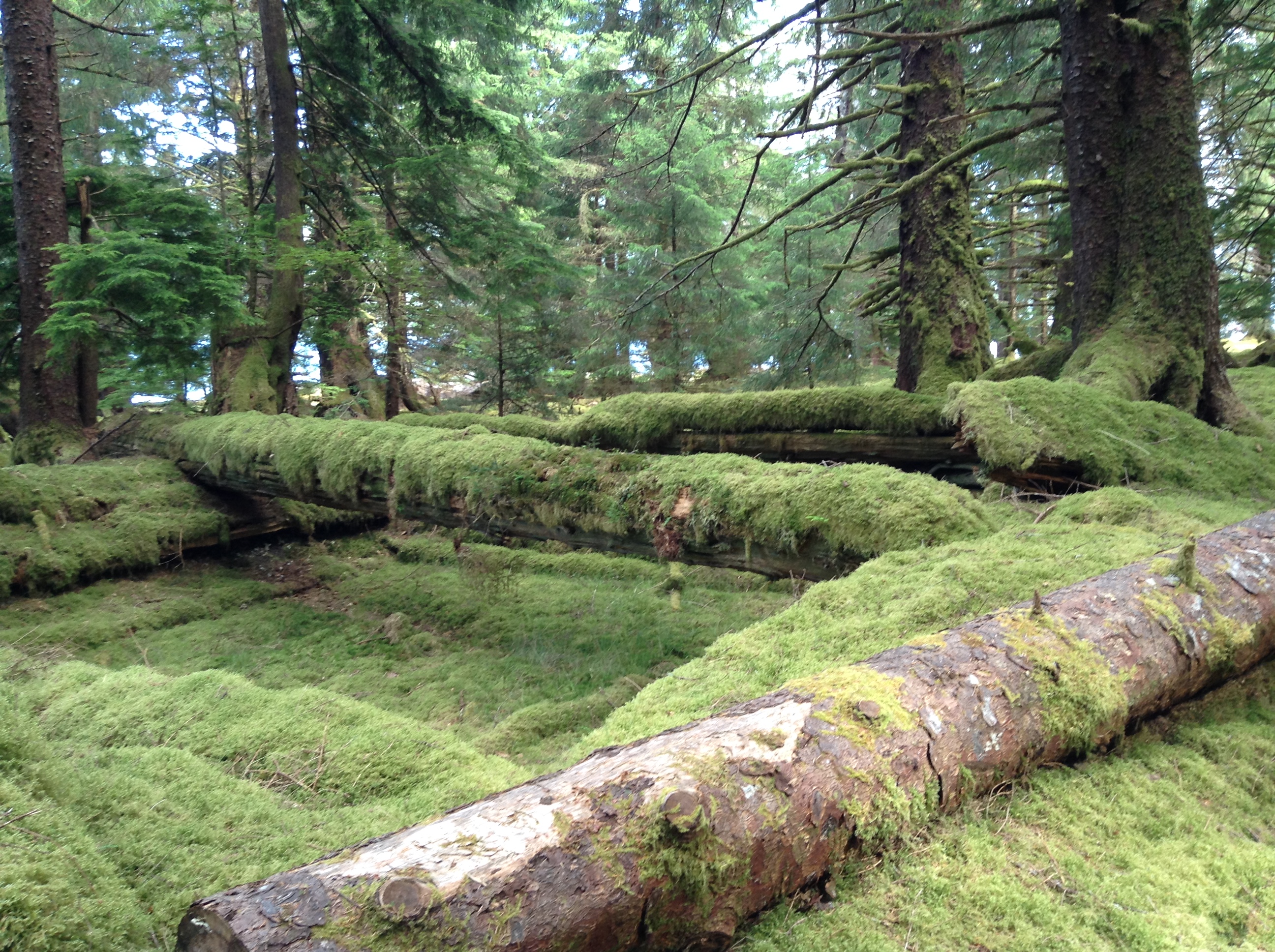
These too will be gone in another decade, reclaimed by the rainforest.
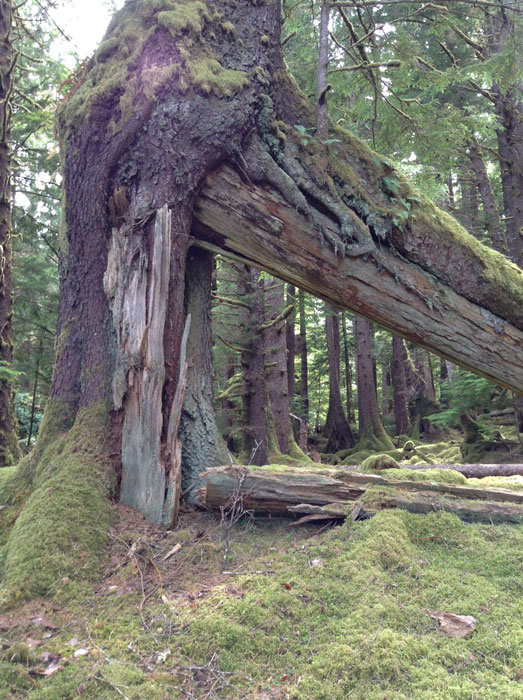
One corner pole still holds up its end of a roof beam. The pole is a nurse log. The newer tree has cast a long root sloping down the roof beam to ground.
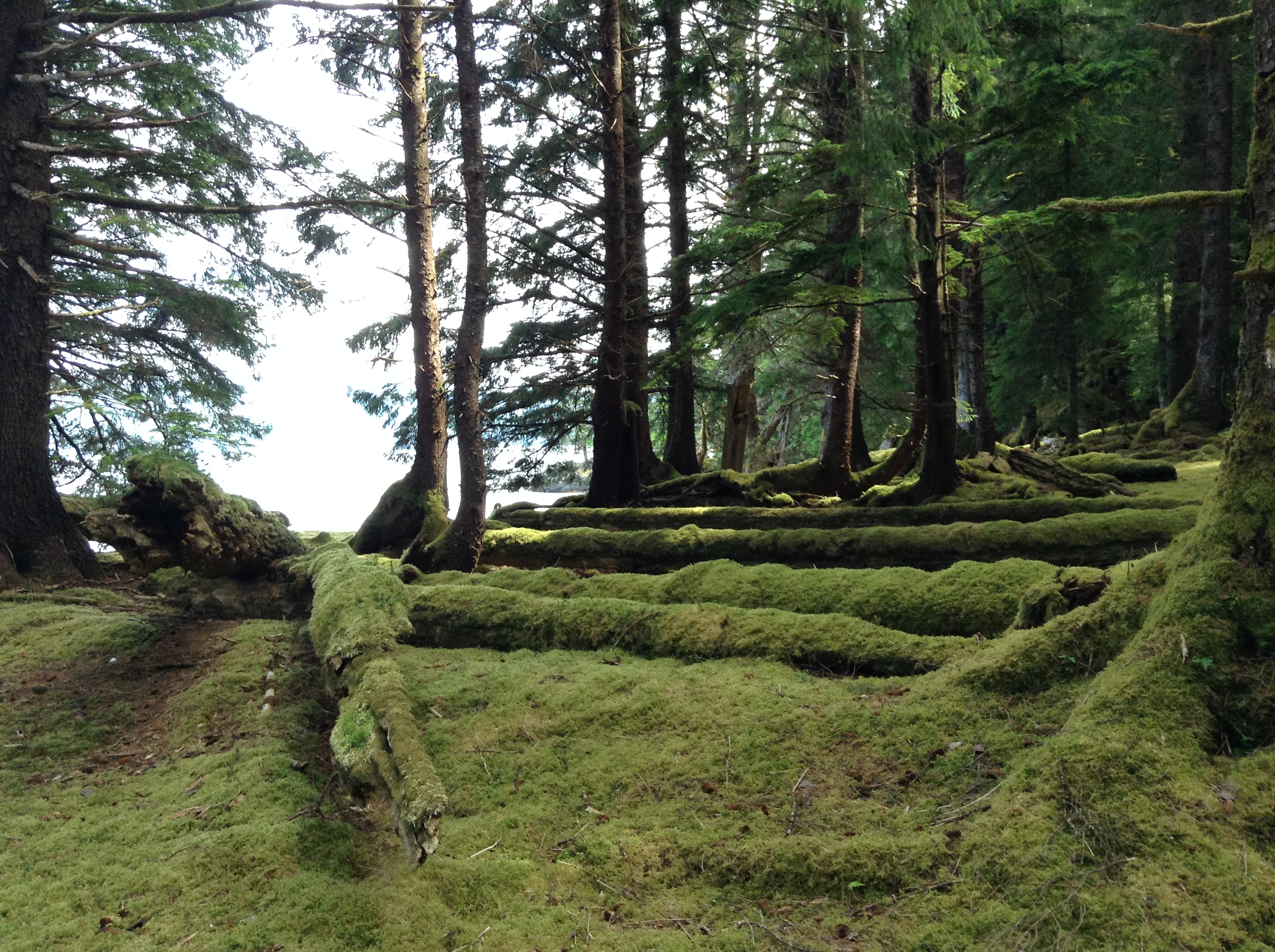
Most beams are prone on the ground. They only lasted this long because they are cedar.
July 25 - Windy Bay to Ramsey Island
At Walter's suggestion (crabs for sure) we enjoyed a quiet night but no crabs in Echo Bay, then went back out to the east end of Lyall Island to visit Windy Bay, another watchman site. Lyall is the site of a protest against clearcut logging that resulted in the creation of Gwaii Haanas as a protected reserve, and is deeply important to the Haida as the symbol of their effective resistance. A new pole was carved in Skidegate and erected here that tells old and recent history, packed with symbols. A house ashore was originally built for the protest, and today houses a summer youth program, and when available, an overnight refuge for kayakers. The house painting shows a squinting face: the Haida faced off against the provincial government, and didn't blink first.
We walked a forest trail, past rotting logs deeply shrouded in thick moss, waded the stream, crossed a black mud pool over a log bridge, found a huge 80 year old spruce, and ferried ourselves back across the river in a skiff tied to a clothesline pulley system.
Again the watchman (woman) gave great information, about the protest, pole and her husband's role as director of the Skidegate Museum. She said Haida remains, removed to museums in other countries, are slowly being returned and properly buried. Her husband is working to reacquire artifacts removed from Haida Gwaii under the guise of preservation.
We pulled anchor and headed south again to a small cove on the north end of Ramsey, grabbing one of the two public moorings for the night. Dave, the undefeated optimist, is dropping the crabpots in.
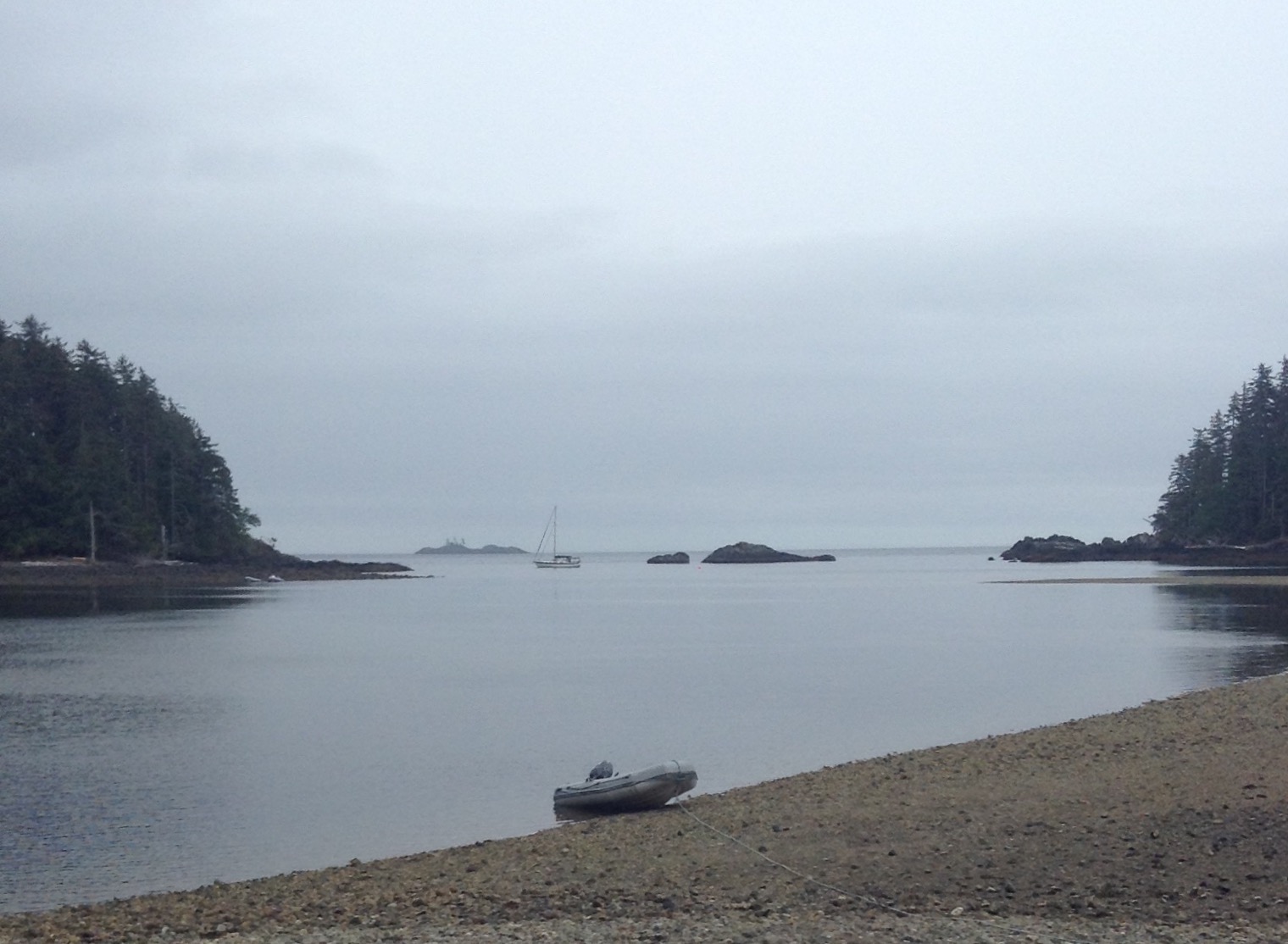
We carry on to Windy Bay.
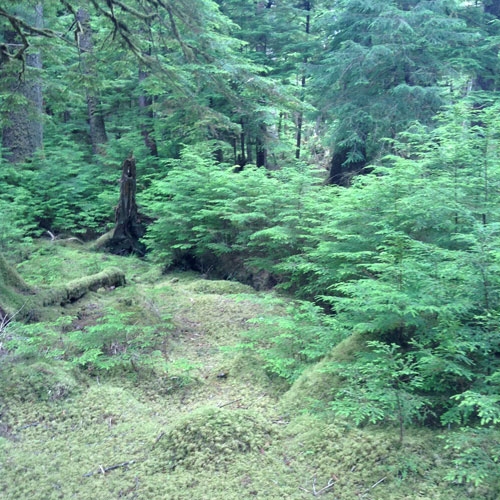
Another watchman site, though not a village.
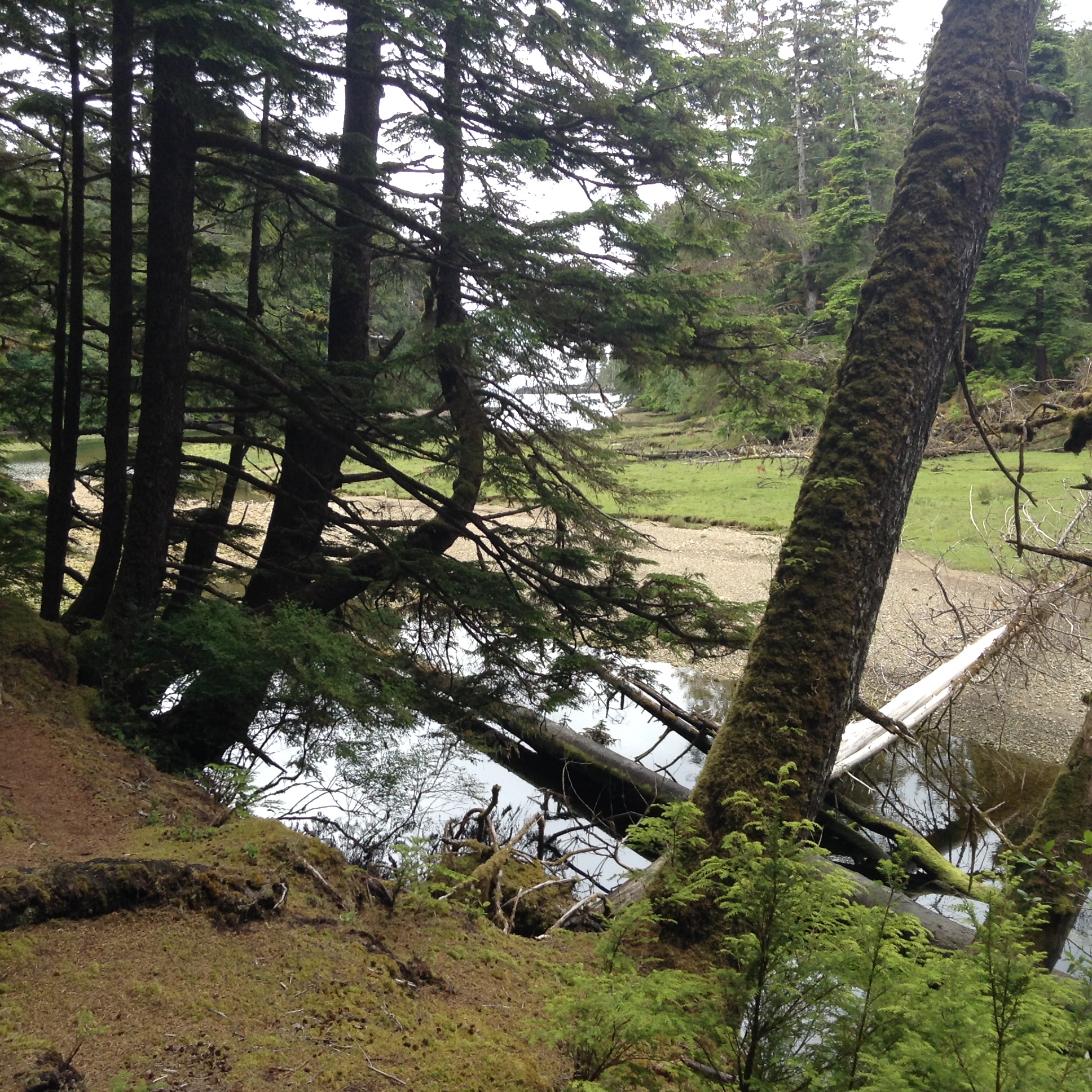
We go for a forest hike
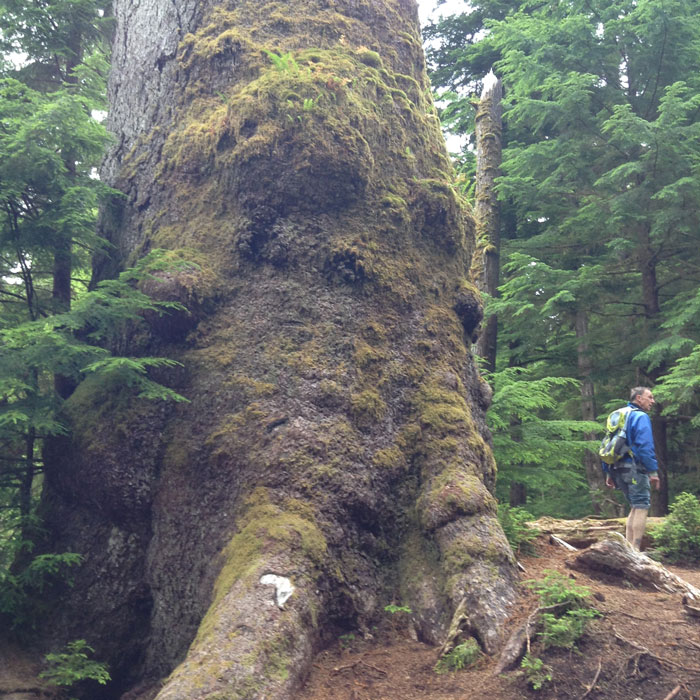
to visit a giant spruce.
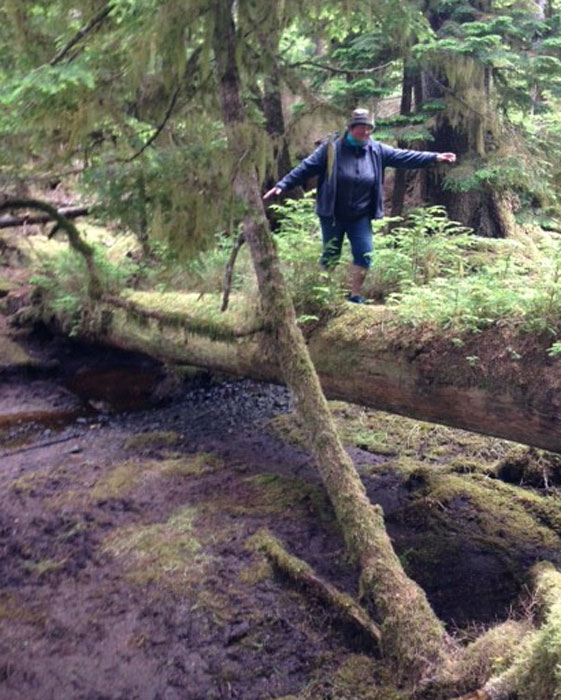
A log bridge lets us cross above the black mud.
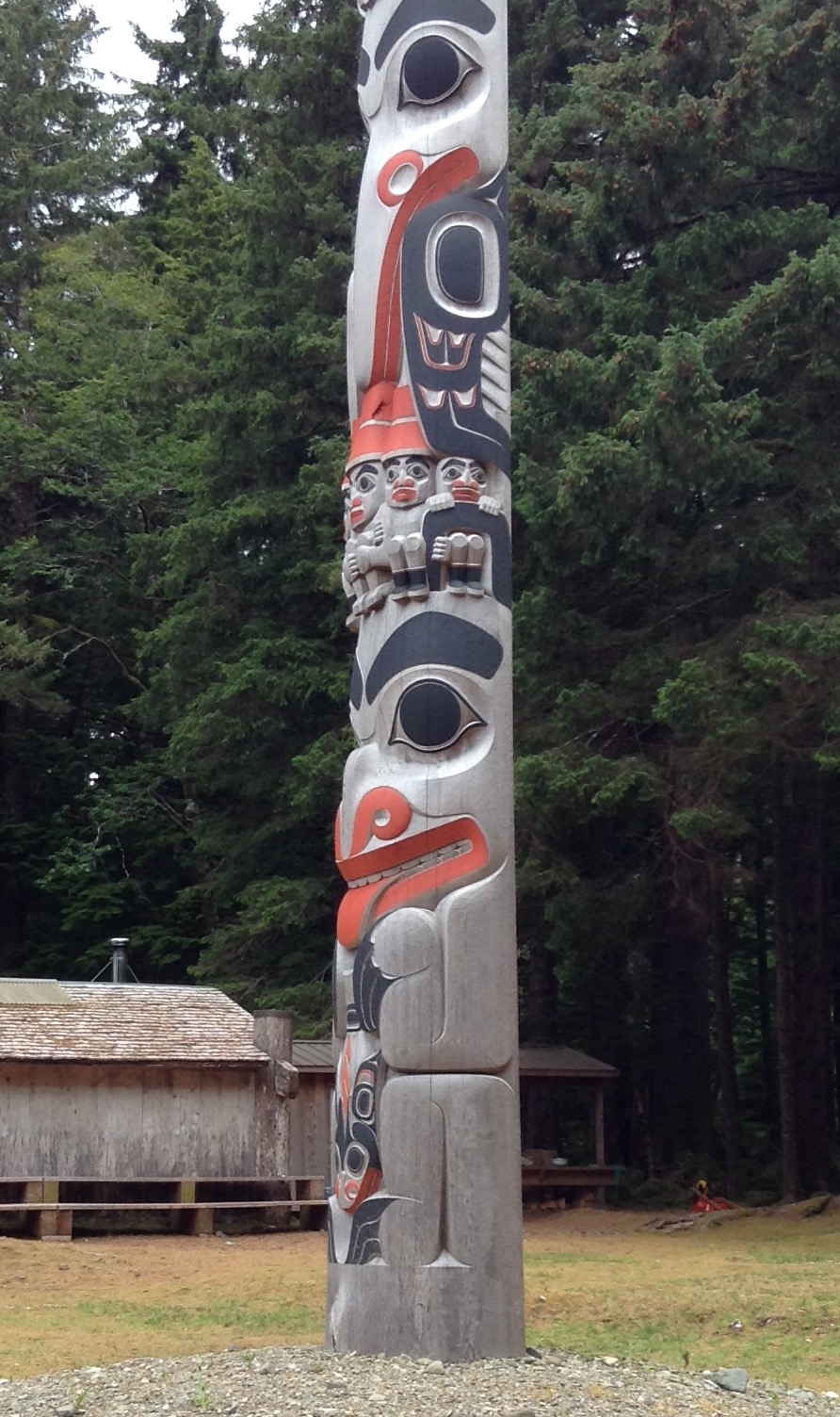
A new pole commemorates the importance of Windy Bay.
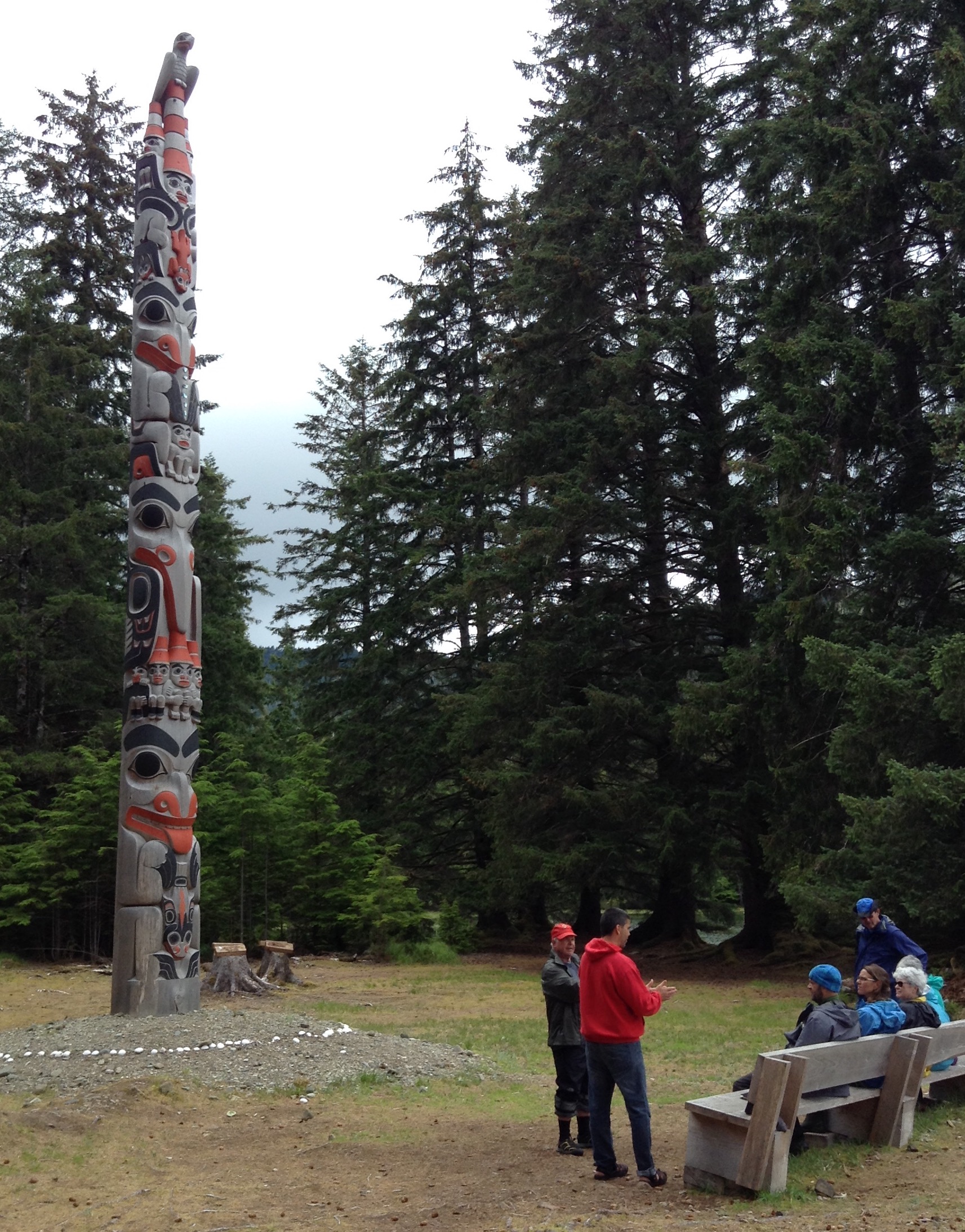
Protests here against logging resulted in the creation of Gwaii Haanas as a reserve.
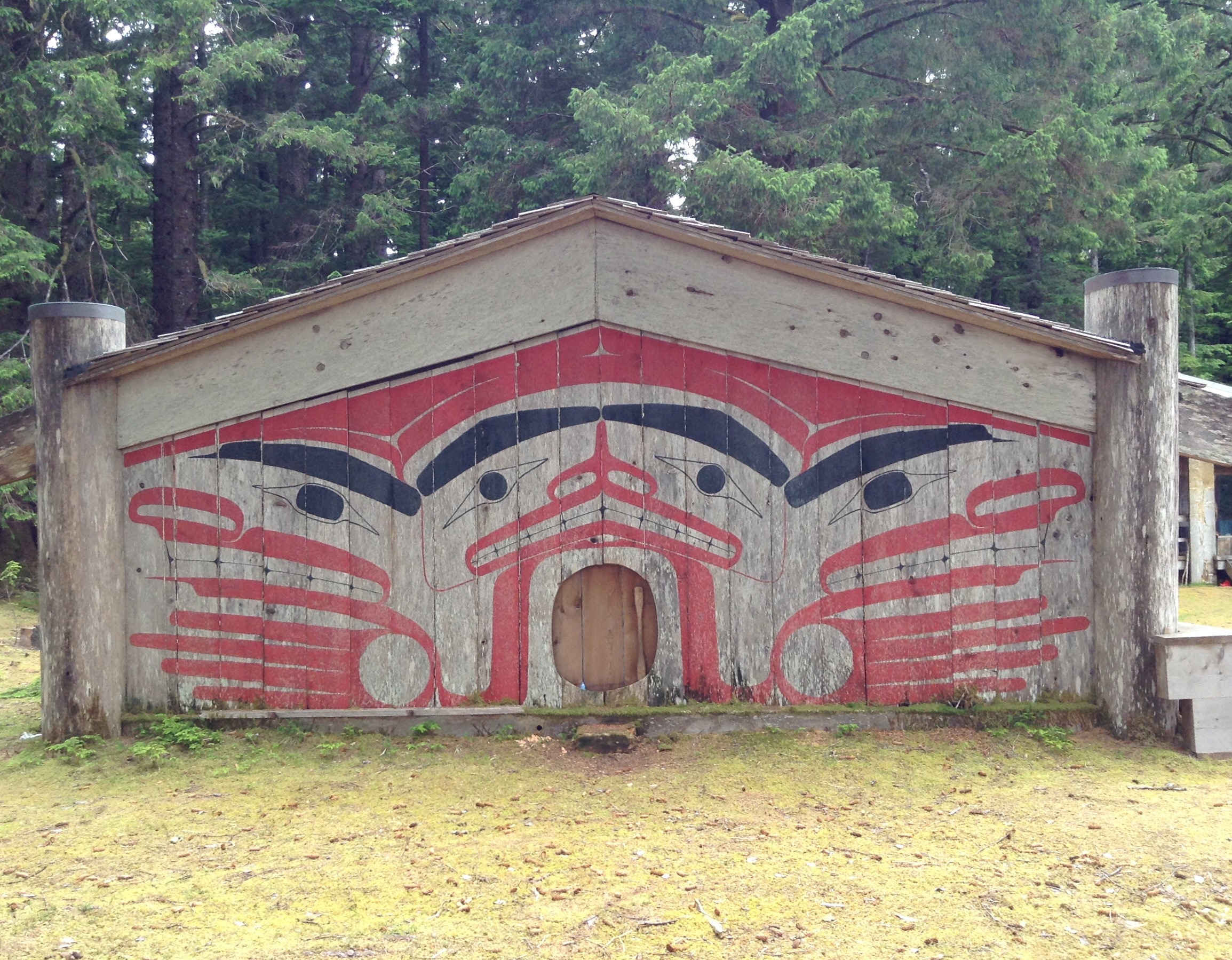
The house that didn't blink.
Today this building, built in support of the protests, houses Haida summer programs and visiting kayakers.
July 26 - Ikeda Bay
Dave spent the morning fixing the down windlass switch, cleaning the contacts then rebedding it on the foredeck, then checking the crabpots (empty). We'd decided to stay put today and let some weather go by, but by early afternoon things seemed benign, and the barometer was rising, so we dropped the buoy lines and headed around Ramsey, then south to Ikeda, a long skinny inlet with great shelter. Unfortunately the bay is choked with red jellyfish, so the crabpots will stay on deck!
We had intended to carry on tomorrow to Rose Harbor, but after listening to the weather forecast, Dave decided we should make our crossing tomorrow. I had been looking at our options, and if we get the W-SW winds that are forecast, we can make Calvert Island in about 24 hours. We haven't done an overnighter since Neah Bay landfall 3 years ago. At least the nights up here are short, maybe only 6 hours of darkness. In another couple days strong SE winds are forecast, exactly what we don't want, so it is prudent to go now. Dave has booked a flight from Port Hardy on August 3rd, and we want a good buffer so we don't fret about making it in time.
So tomorrow morning we will load the dinghy and secure everything, and head out sometime in the morning.
July 27 - Underway across Hecate/Queen Charlotte Straits
Easy day so far, making decent time under sail, motor off! We are once again a sailboat, first time this year. Dave had to remind me about the "finger puppet" when we set the shaft brake. We use the brake to prevent the shaft from turning the transmission without oil, which would burn it up. I made a small glove that fits over the shift lever as a reminder that we need to pulse the engine in reverse to release the brake when we motor again.
Haida Gwaii is now an indistinct smudge on the horizon. Glad we went there. It is a special place, and a piece of rapidly vanishing architectural history, though the proud Haida are actively working to keep their culture alive. As much as we've travelled, there are still amazing places awaiting our discovery.
Click here for the next leg of our trip, down the west side of Vancouver Island.